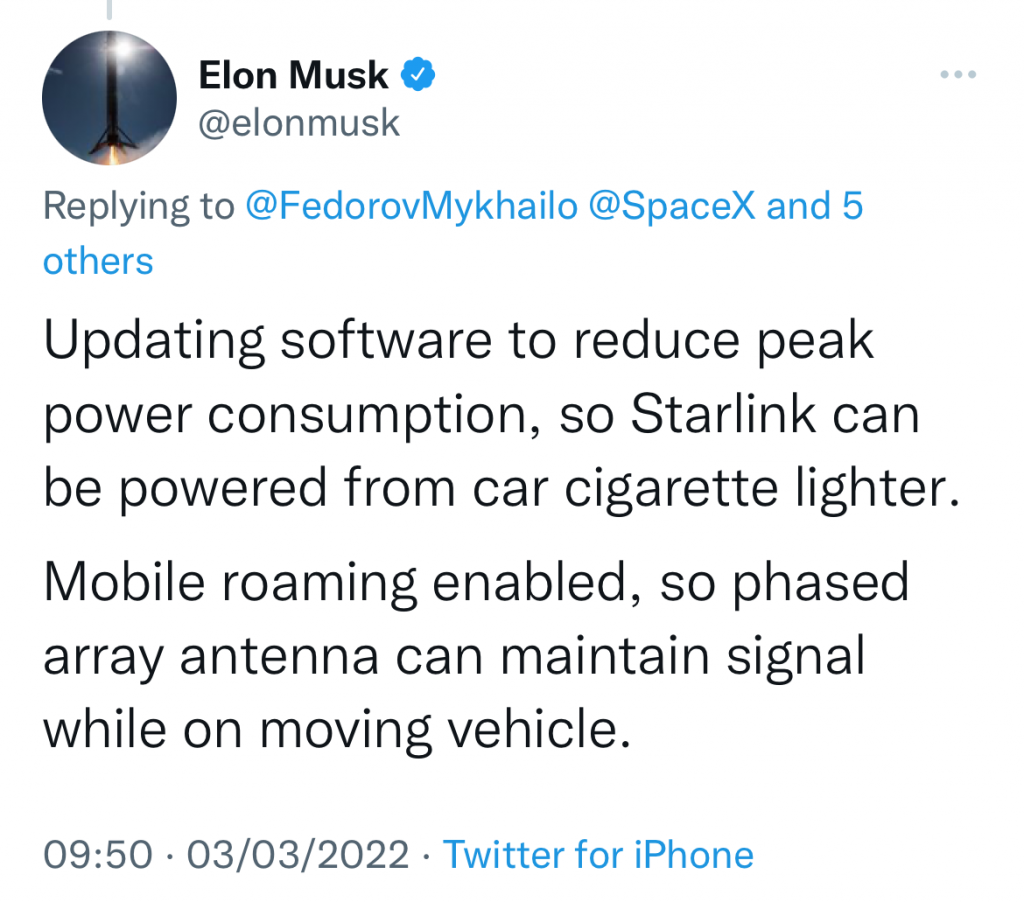
Elon Tweeted “Mobile roaming enabled, so phased array antenna can maintain signal while on moving vehicle”. Hmmm… interesting! I guess that in context, he probably meant for this to apply to his recent supply of Starlink terminals to the brave souls defending Ukraine. But it got me thinking… if it can work in Ukraine, could it work for a couple of British overlanders touring around North America too? We’re lucky to have roaming enabled on our system, so could I stick our Dish on our RV roof and get Starlink mobile roaming… internet ‘in motion’? 🤔
(** see important note here on ‘in motion’ use)
- Update No. 1: Tyre cover over dish (5 Mar 22)
- Update No. 2: Roaming is now called ‘Portability’ and slight modification to our installation (28 Mar 22)
- Update No. 3: Roaming in motion with a rectangular dish (13 Apr 22)
- Update No. 4: Tie down modification for dish (1 May 22)
- Update No. 5: Official Portability announced (4 May 22)
- Update No. 6: Report on testing above 57N in North America (23 Jul 22)
- Update No. 7: FCC approval for SpaceX Starlink ‘Earth Station In Motion’ (26 Jul 22)
- Update No. 8: Starlink and Geostationary Satellites (9 Aug 22)
- Update No. 9: A few recent things we’ve noticed (22 Sep 22)
- Update No.10: Flat High Performance dish and laser links (2/10/22)
- Update No.11: In-motion working again (3/10/22)
- Update No.12: Global Roaming, end of Portability and price changes in the USA (24/2/23)
If you sign up for Starlink with our referral code (click here), we will each receive one month of free service 30 days after activation. For more information on how it works, check out Starlink support topics here.
Can Starlink Roam in Motion?
To see if a Starlink Dish, designed for static use, will still work whilst in motion on vehicle needs a bit of thought. I can’t just chuck it on the roof and drive. The two main considerations I had were:
- The motors on the Dish would probably be incapable of keeping up with the vehicle’s motion. I could disable the motors and fix the Dish in a horizontal position (pointing up), but how would the software handle the Dish’s inability to move and point towards the satellites? and
- The normal mount is probably not strong enough to safely hold the dish in place on the roof in the event of the forces of an accident/impact. I would need to find a way to mount the Dish horizontally, but securely, to carry out the test.
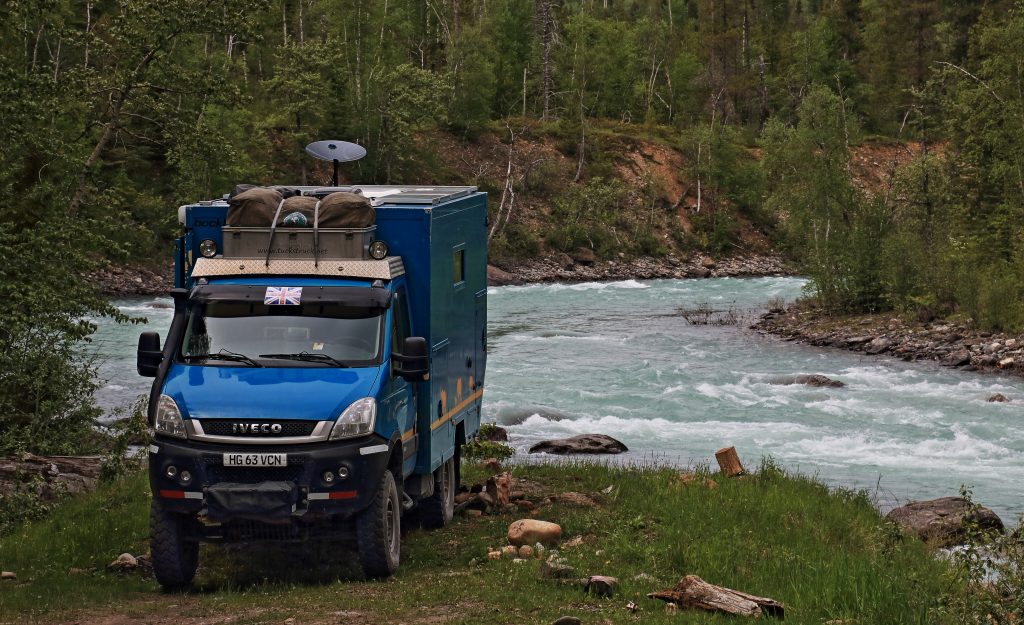
The Dish Movement
The Dish appears to have a 9-axis sensor (3 axis Accelerometers, Gyros and Magnetometers) which it uses initially to level the dish on powering-up, then to turn and tilt the dish to the optimum direction to connect to satellites. I think this 9-axis sensor is probably also used to adjust the phase array’s beam steering action to compensate for dish movement.
I reached the above conclusion on the basis that: i) I recall SpaceX once saying that it is fine to mount the Dish up a tree that can sway around in the wind; ii) I’ve seen that SpaceX have the Dishes mounted on their drone ships used for recoveries of their Falcon 9 rockets; and iii) SpaceX have installed Starlink on the side of a Starship and flown it to 30,000’ and back! The beam steering correction of the 9-axis sensor would be able to handle far faster angle changes in pitch, roll and azimuth than the electric motors could.
Before trying to use the Dish whilst driving, I tested how it works in a fixed horizontal position:
- I disconnected the motors with the Dish horizontal (pointing straight up), before powering-up the Dish.
- When I powered the Dish up, it initially connected to the satellites in the normal way.
- After 3 minutes, when it would normally rotate and pitch to the optimum angle, it lost signal. I suspect the software had issued the command to move the Dish and started tracking the satellite on the assumption that the Dish had actually moved; but as the Dish hadn’t physically moved, it couldn’t see the satellite it was trying to find in the direction it was looking.
- After a further 2.5 minutes the ‘Starlink Motors Stuck’ warning appeared. The system seems to have identified that the motors hadn’t moved the Dish.
- As a result of this lack of movement, the system seemed to change its strategy. The ‘Starlink Motors Stuck’ warning remained, but the system quickly reassessed the situation and regained signal with the satellites.
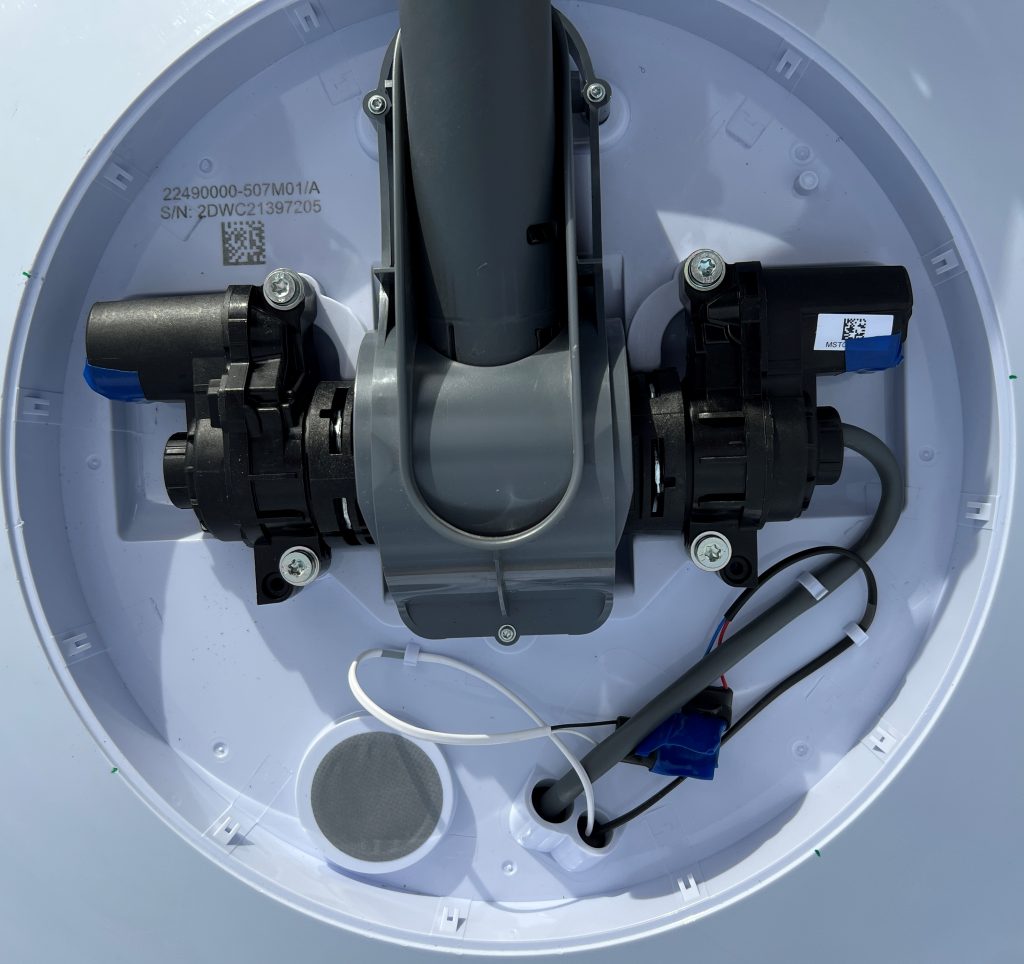
That test indicates that normal operations do work with the Dish fixed horizontally (pointing straight up). However, there will inevitably be some performance loss. As the Dish has a field of view of 100 degrees it will not, whilst horizontal, be able to track the satellites all the way to the horizon. This will become less critical as more satellites are launched.
Securing the Dish to the Vehicle
As the Dish no longer moves around during use, it is much easier to fix the Dish securely on the vehicle for use in motion. For this trial I didn’t want to make any permanent modifications to the Dish, so I did a temporary fix of the Dish using our spare tyre on the roof as a cradle to support the Dish.
With the Dish’s motor cover removed, I threaded two straps around the motor gearbox, down through the centre of the tyre, out the underside of the tyre, then firmly attached to the roof tie down tracks. Finally, another two straps (the two which originally secured just the spare tyre) are run over the top of the Dish to secure both it, and the tyre. Importantly, these two straps are gripping firmly on the tyre sidewall, but sit only lightly on the Dish face, avoiding damage to the Dish face (our dish – rev2 Grey- has a hard plastic face and is much stronger than the fabric face on our original rev1 Black dish).
Note: We now have a rectangular dish, see our installation here.
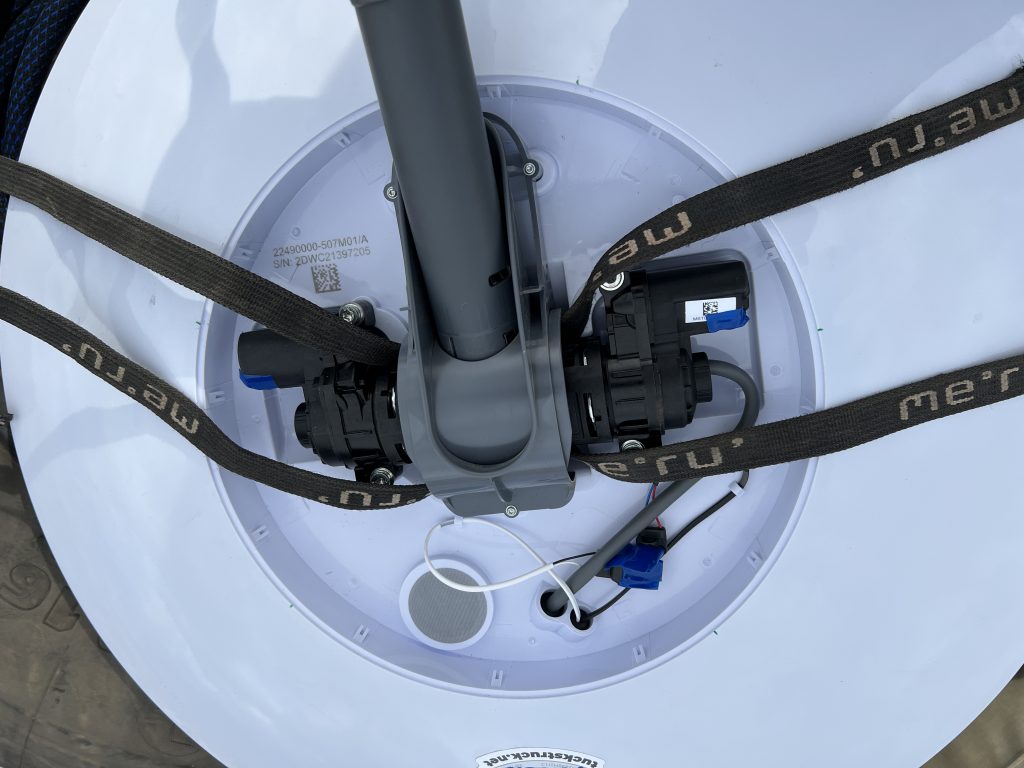
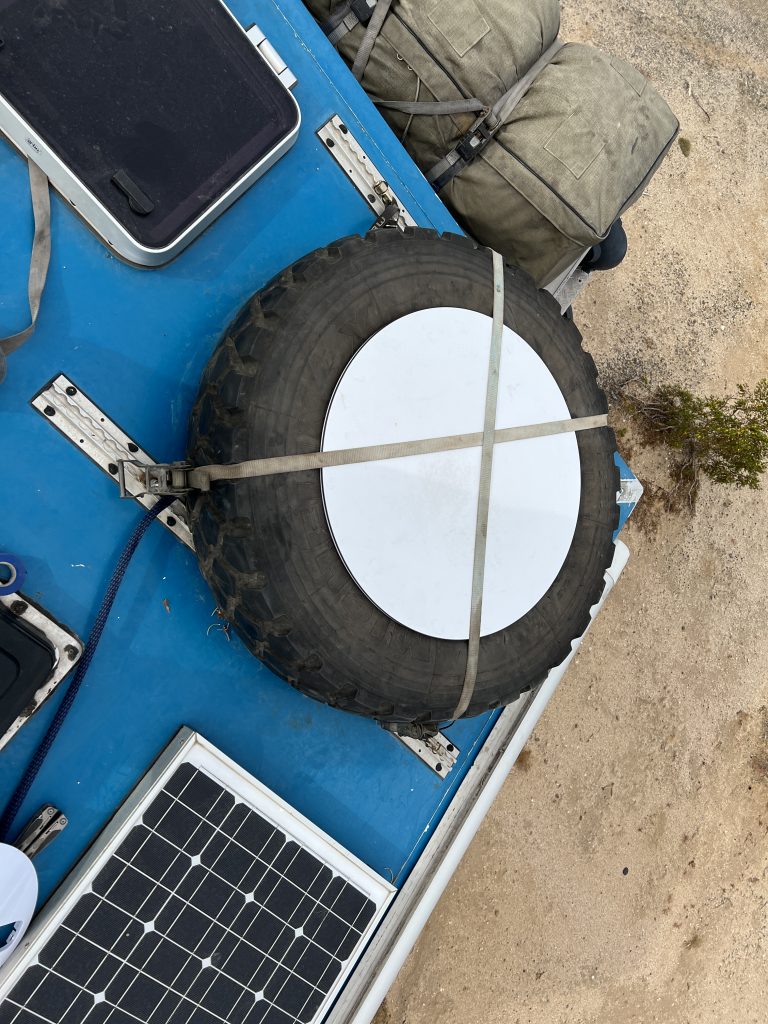
The Mobile Roaming Test
I put the Starlink mobile roaming on a vehicle in motion to the test with:
- live streaming video in 2K (the Everyday Astronaut, Tim Dodd’s excellent YouTube video “Will Starship Make The Artemis Program Better Than Apollo?”); and at the same time
- my wife listening to a live UK radio broadcast whilst doing a range of general internet surfing, social media etc.
We drove 163 km (101 miles) from our camp spot in the Anza-Borrego desert to a location north-west of Yuma at an average speed of 73 kph (45 mph) and top speed of 87 kph (54 mph).
As we drove, the video stream was running on my laptop in the RV rear cabin. So that I could do a post drive analysis of performance, I set my laptop to take a screen-recording of the Starlink ‘Network Statistics’ page and Ping Plotter. Below is a graph from the Ping Plotter data. It looks a little spiky to me, but I’m not an IT guy so I will let others assess the performance. It averaged a latency of below 50 ms, I think many of the spikes could be short interruptions in connection, possibly as we drove past obstructions.

However, the Starlink Network Statistics looked a lot better, recording only 1 minute of network issues and 1 minute of unknown issues over the 2-hour period Starlink was on. The video below is the Ping Plotter, Starlink Network Statists and dash cam footage recorded over 1 hour 50 min (laptop battery died – schoolboy error, should have had it plugged in!) speeded up to 2 min. You can see some correlation between the drop outs on the Ping Plotter/Network Statistics and physical obstructions in the dash cam video. Unfortunately, I have no idea which direction the Starlink was look at any given time.
The average power was not significantly different to normal static use, within 1 watt.
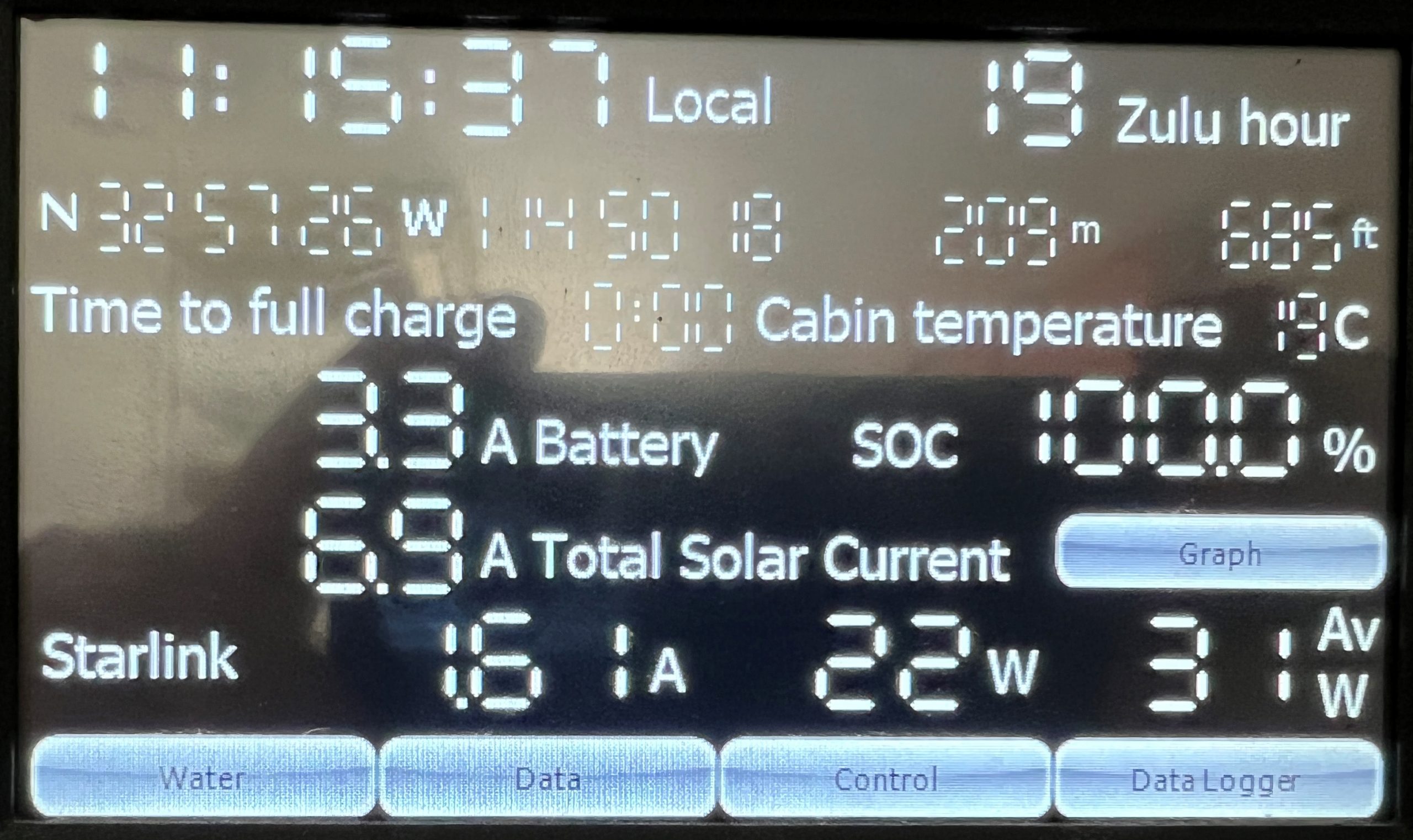
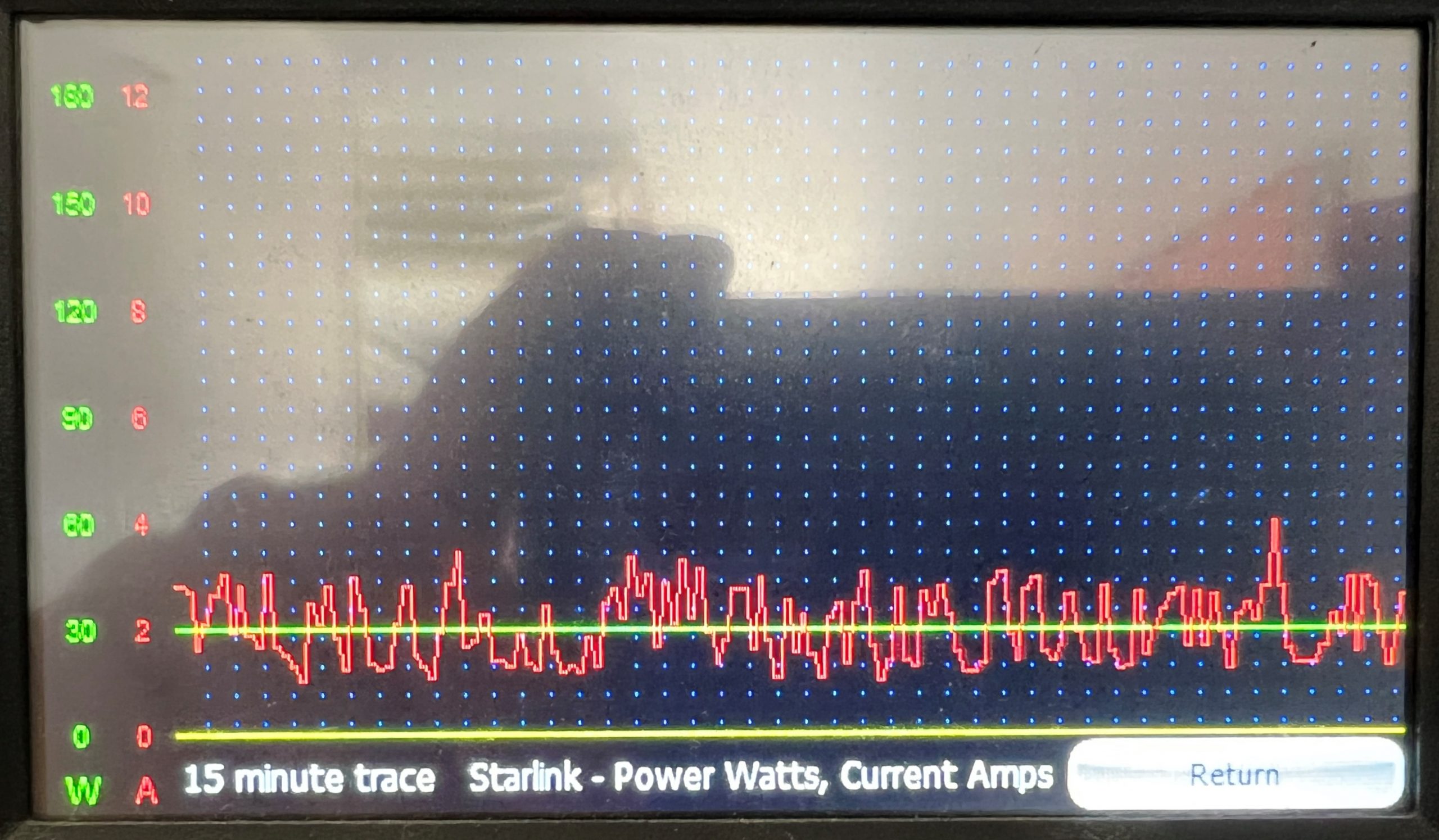
We didn’t perform speed tests while driving as we had all the data streaming. However, the static speed tests with the dish horizontal are showing satisfactory performance. Upload is possibly a little lower than when the dish is tilted (or could it just be the test server in Tijuana just over the border!). We have had the following results:
217 Mbs down, 11.6 Mbs up, 31 ms – Geolinks LA
195 Mbs down, 1.47 Mbs up, 33 ms – Transtelso Tijuana
138 Mbs down, 7.10 Mbs up, 41 ms – Transtelso Tijuana
189 Mbs down, 9.10 Mbs up, 37 ms – Transtelso Tijuana
55.3 Mbs down, 5.98 Mbs up, 45 ms – Transtelso Tijuana
194 Mbs down, 7.16 Mbs up, 51 ms – Transtelso Tijuana
245 Mbs down, 13.8 Mbs up, 31 ms – Spacelink San Diego
129 Mbs down, 7.98 Mbs up, 44 ms – AT&T San Diego
Interesting to see that the obstruction viewer shows the dish horizontal.
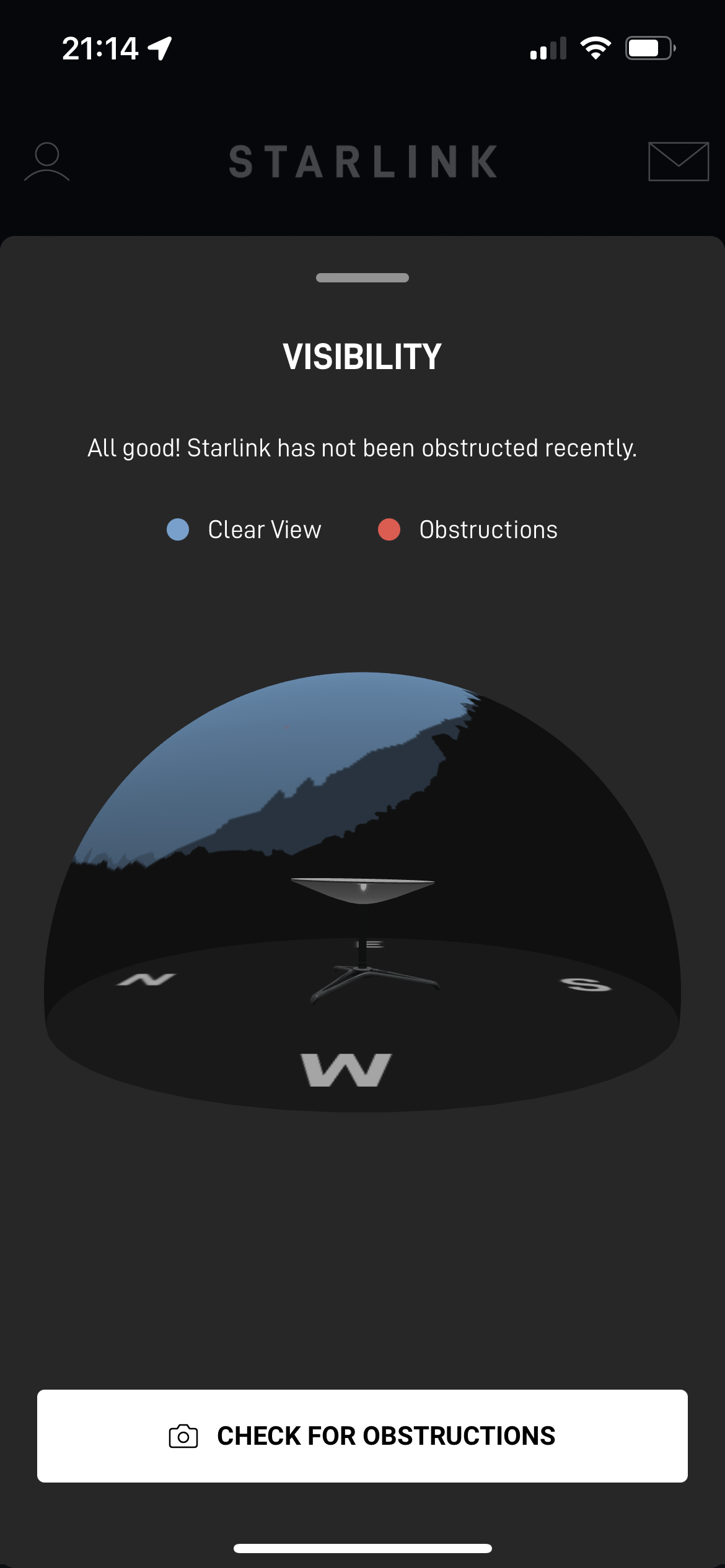
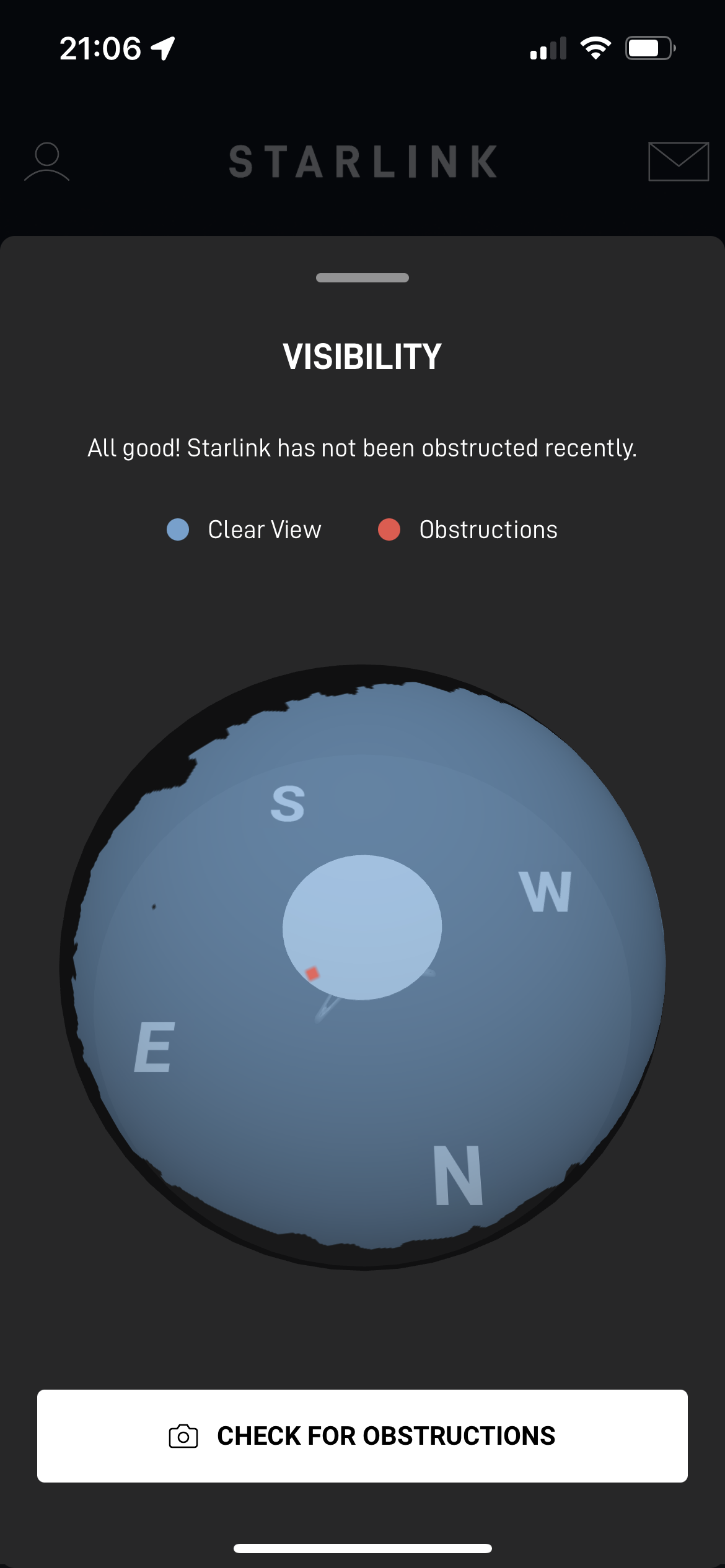
Conclusion – Top stuff from Elon Musk yet again. Starlink mobile roaming is impressive, huh? 😉
Update No. 1: Tyre cover over dish (5 Mar 22)
Tyre cover reinstalled over the dish and tyre. No effect on performance today, but I’ll have to keep an eye on the temperture in the summer to check it doesn’t get too hot.
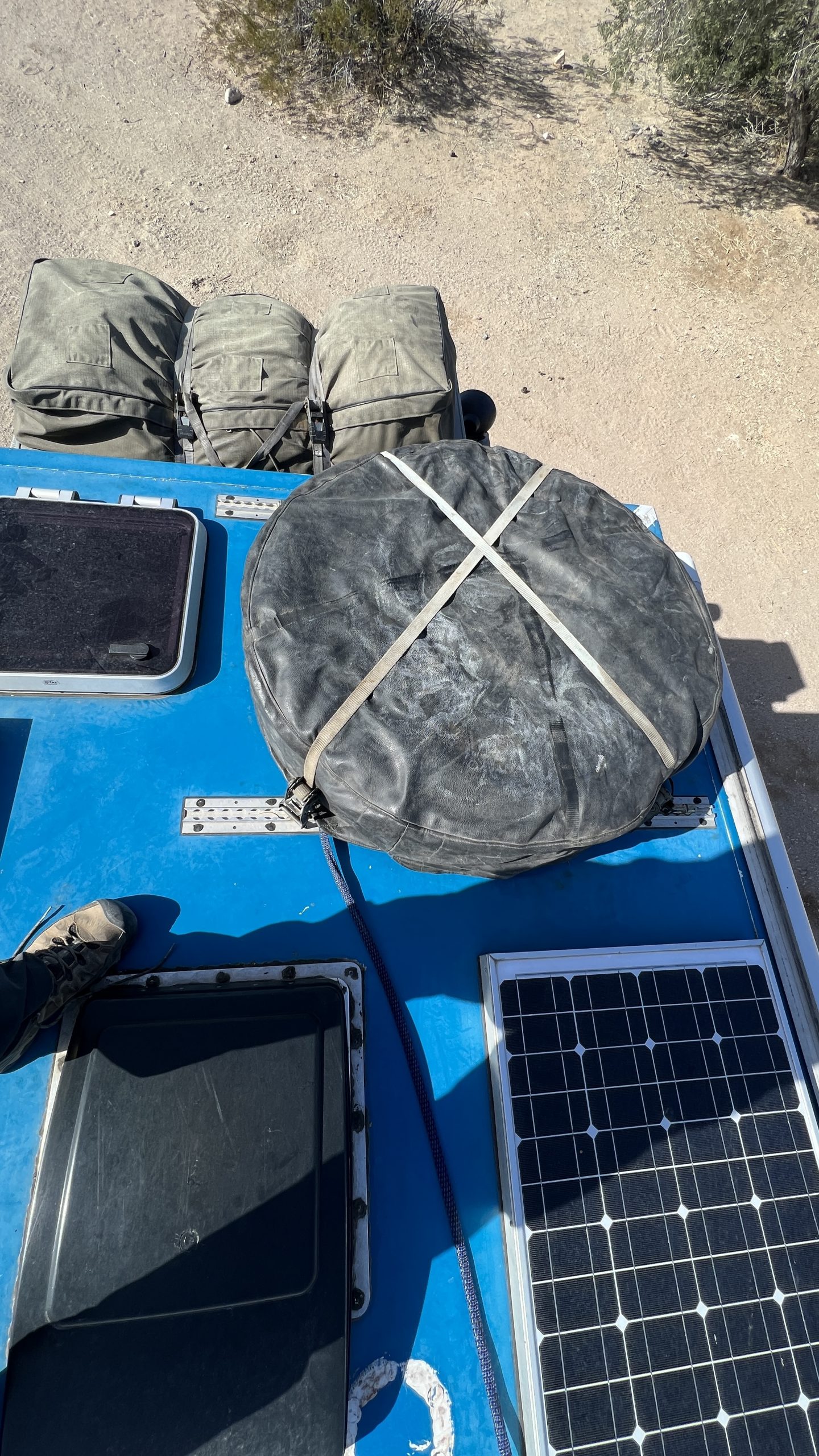
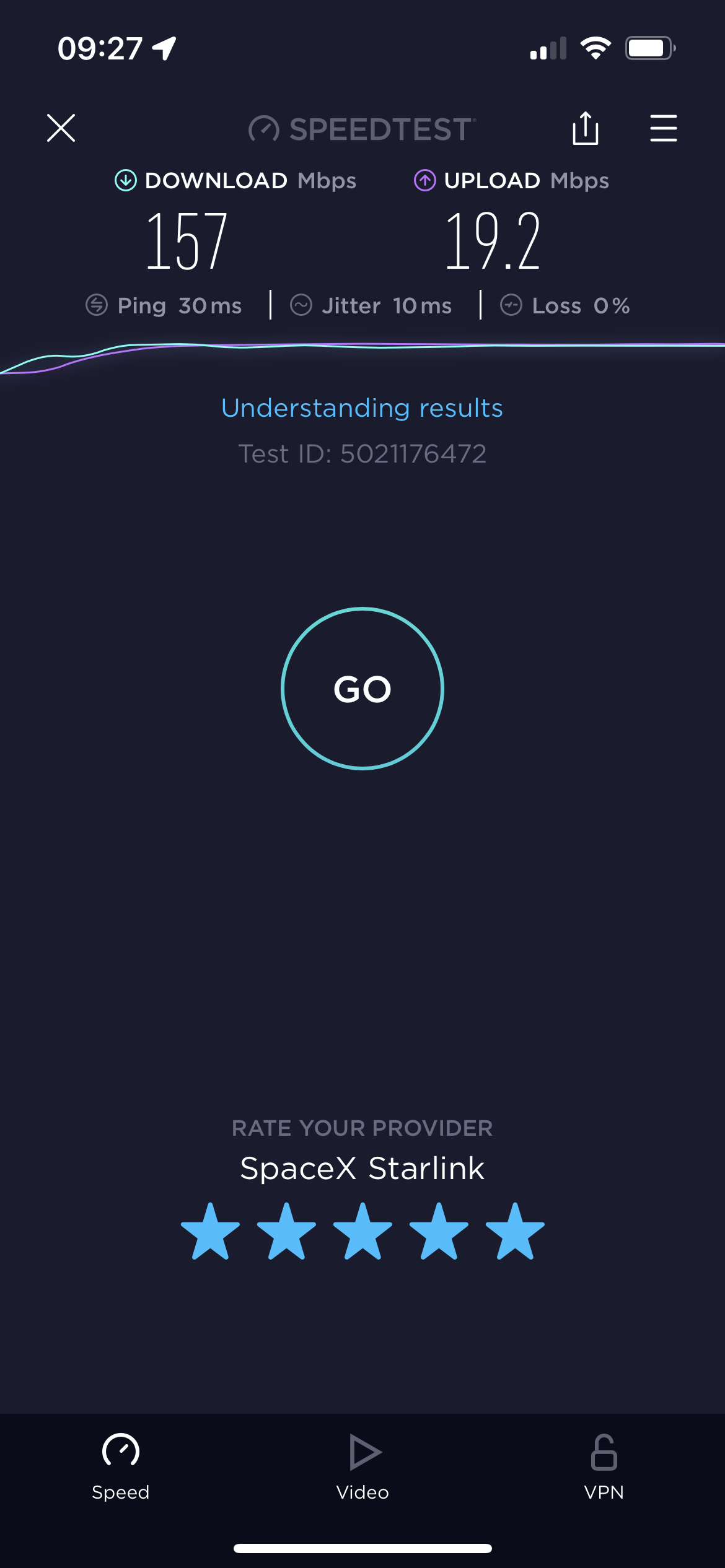
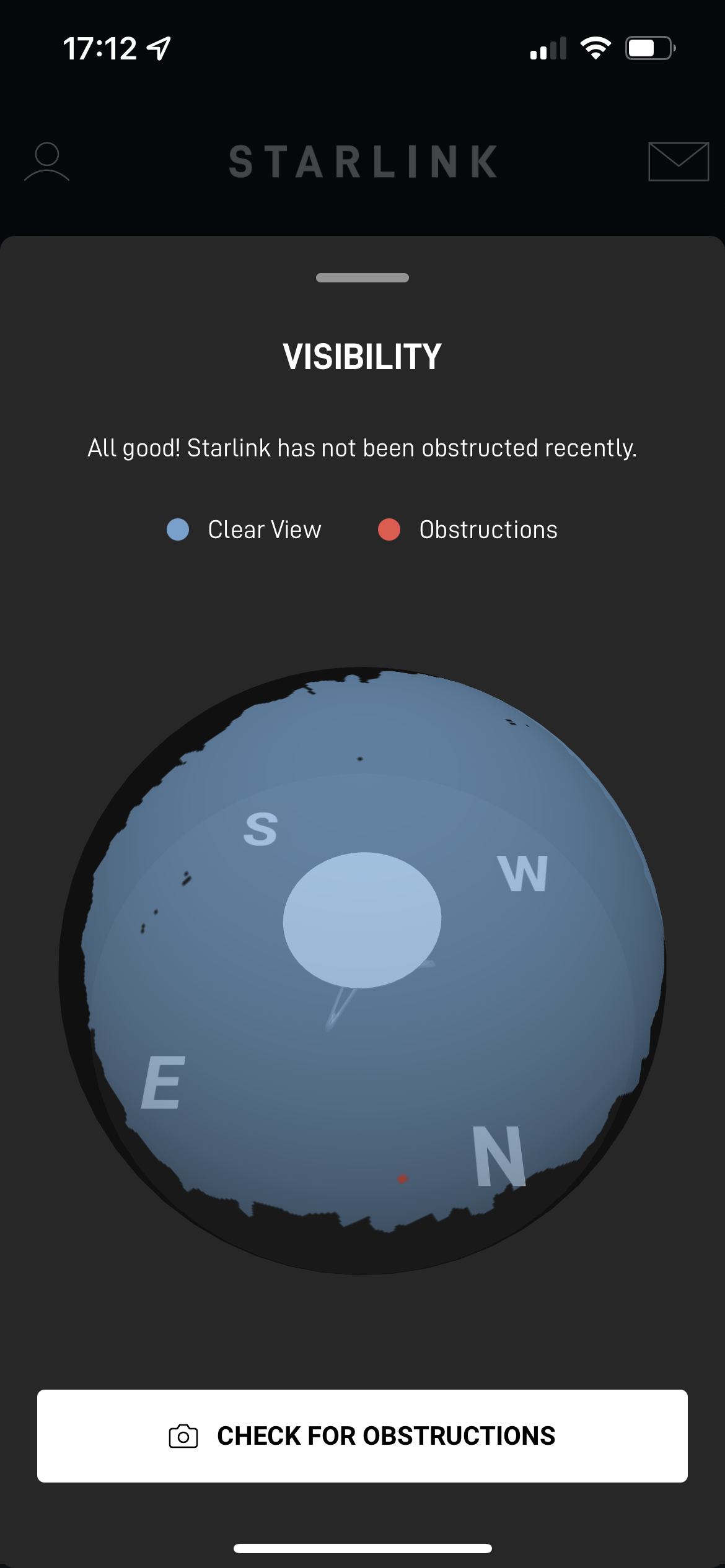
Update No. 2: Roaming is now called ‘Portability’ and slight modification to our installation (28 Mar 22)
It appears that the Roaming feature is called Portability by SpaceX. Recently SpaceX updated their ‘Starlink pre-order agreement’ to include a section for Portability:
SERVICE PORTABILITY.
Secondary Service Locations. If the portability feature (“Portability”) is available in your region, you may relocate your Kit and access Services at locations outside your registered Service address on your account (“Secondary Location(s)”). Service at Secondary Locations will be best effort and users may see slower speeds during times of network congestion. Starlink does not support in motion or mobility Services. Using the Starlink Kit in motion will void the Limited Warranty of your Kit. Visit https://support.starlink.com/ to verify if Portability is supported in a region.
Limitations and Requirements. Starlink does not guarantee when or where Portability will be available. Portability is dependent on many factors, including obtaining the necessary regulatory approvals. You acknowledge and agree that you are solely responsible for (a) understanding and complying with all applicable laws and regulations associated with your use of Portability Services and the Kit; and (b) stopping use of the Portability Services or Kit if you are in an unsupported geographic location. At its sole discretion, Starlink may update the primary address registered on your account along with invoicing requirements if you use Services at a Secondary Location for an extended period.
Installation Change
Using Starlink mounted in the tyre on the roof has worked very well. Now we are roaming in Mexico, the weather is getting warmer. I was concerned that the dish may start to overheat under the black tyre cover in warm weather and direct sunlight. I had been monitoring the Debug data to see if the Dish Thermal Throttling had activated. In temperatures up to 32C, 90F the Dish Thermal Throttling didn’t activate and the Thermal Shutdown didn’t happen. However, as a precaution for even warmer weather I have cut a hole in the tyre cover to expose the dish surface through the top of the tyre cover. The white dish face should now keep cooler and the dish still can’t be seen from the ground.
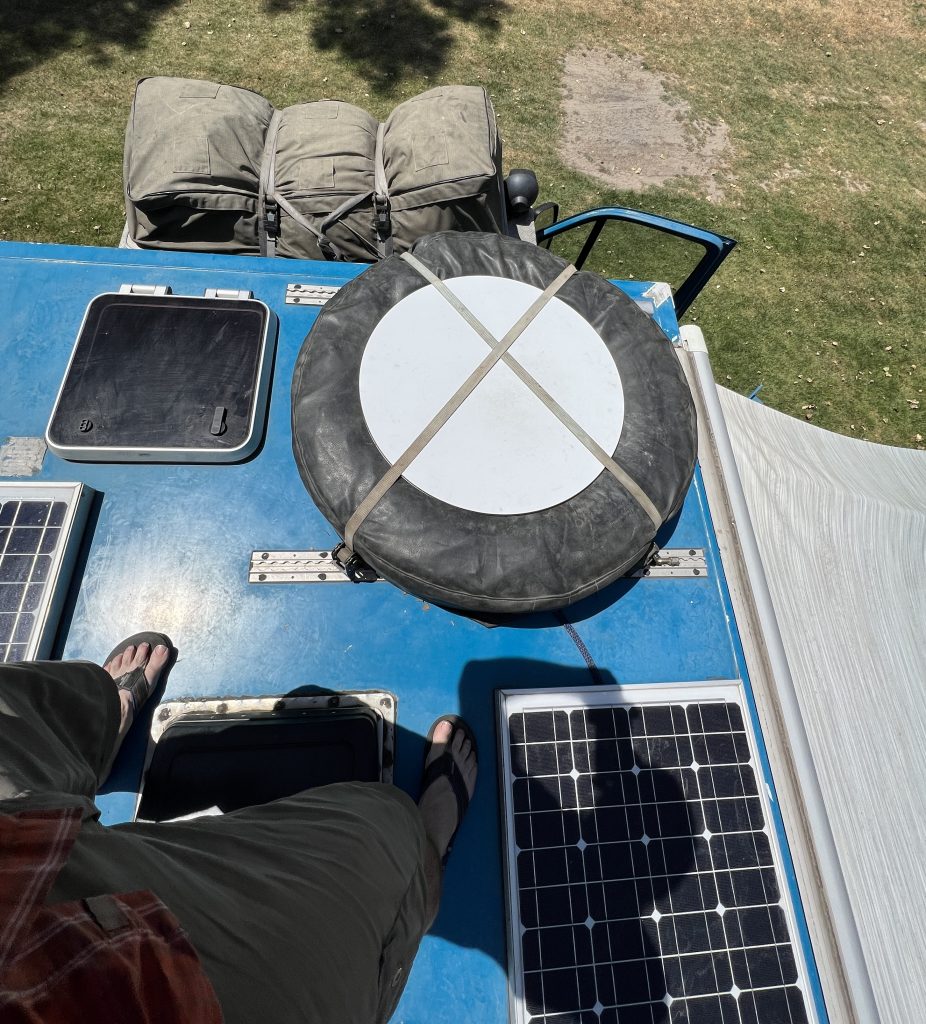
I have also now made a short cable to connect the dish to my roof socket. I threaded this cable through a short length of aluminium tube before fitting the shielded RJ45 connector. This short section of tube is to protect the cable where it is routed under the tyre.
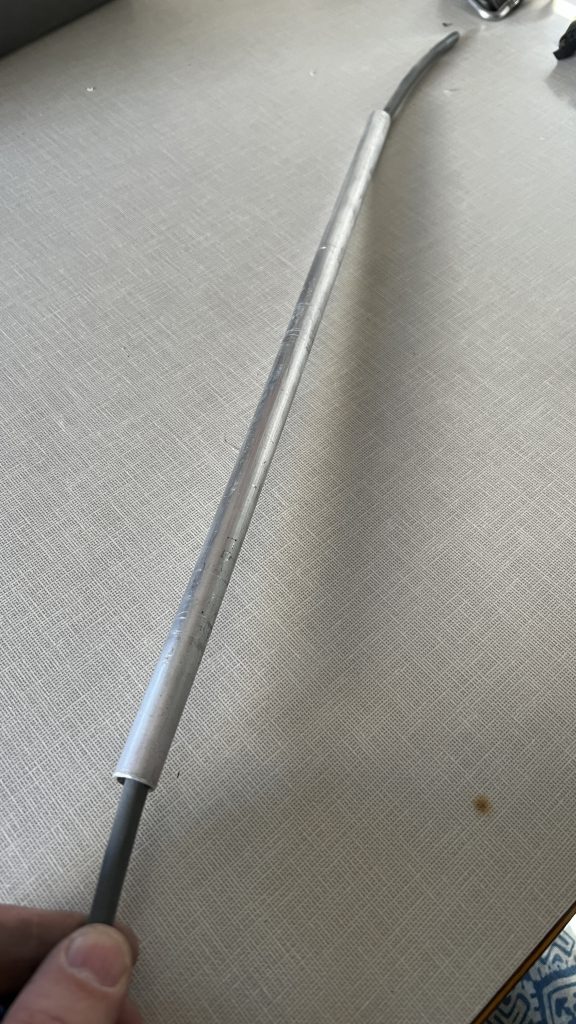
Update No. 3: Roaming in motion with a rectangular dish (13 Apr 22)
We only have a round dish, so our posts so far have been restricted to that model. However, others are experimenting with the rectangular dish too. From what I have seen on social media, Pat Chics (https://outbackusawirelessllc.com) seems to have done the most extensive experimentation with a rectangular dish. He has kindly given us permission to use his photos so you can see what can be done with the rectangular dish.
The rectangular dish is a sealed unit, which makes it difficult to disconnect the motors. Having seen a few teardown videos, Pat was able to estimate the approximate position of the motor connector on the PCB. He then cut a large hole to give him access to the connector.
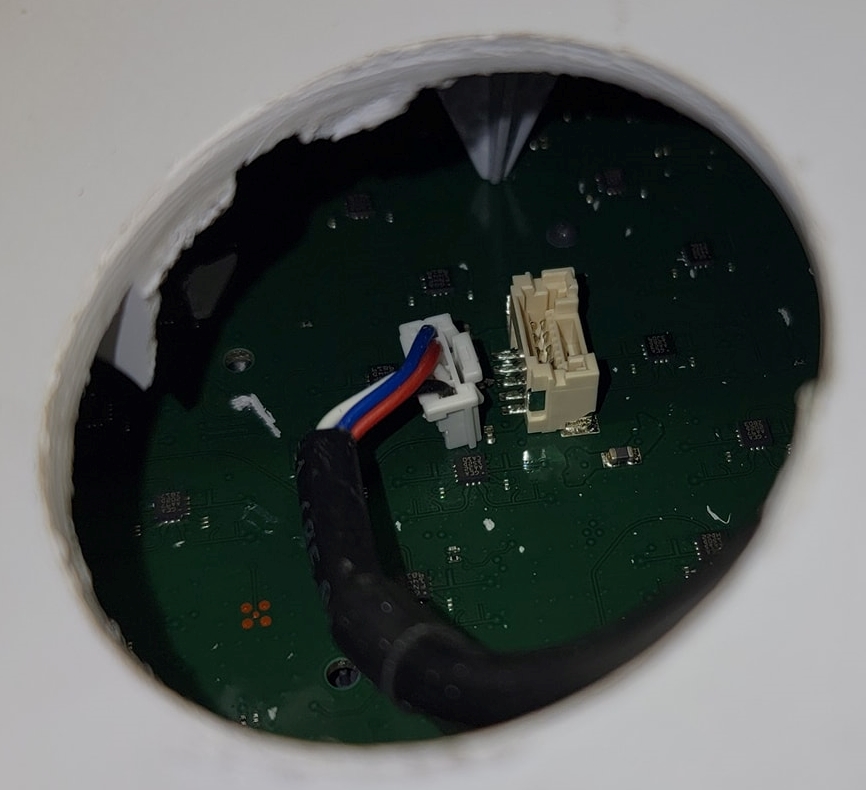
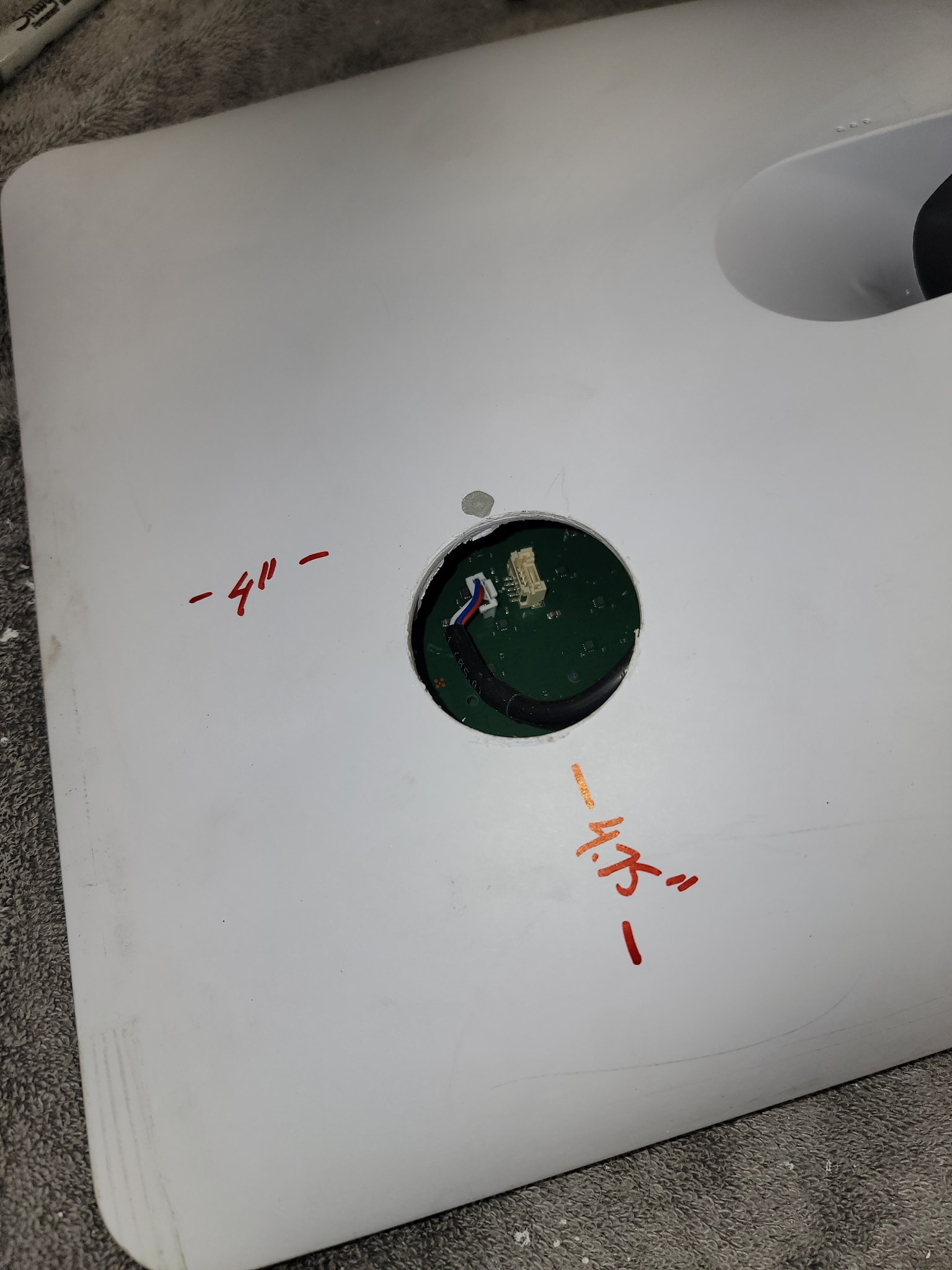
Having cut the hole, he was able to identify its exact position. It is 4” (100 mm) from the bottom of the dish and 4.75” (120 mm) from the right side (I rounded the millimetre measurements slightly as SpaceX tend to use metric measurements).
With the motors unplugged, Pat sealed the hole with a plastic plug over the hole.
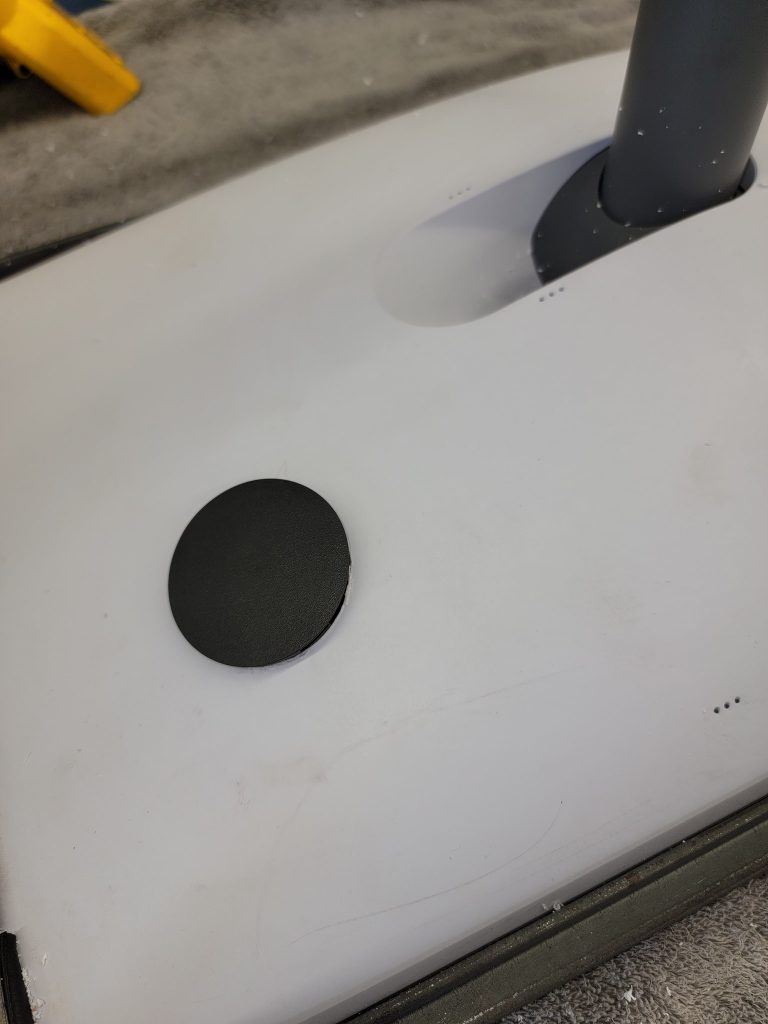
Pat has mounted the dish on his car roof rack very neatly.
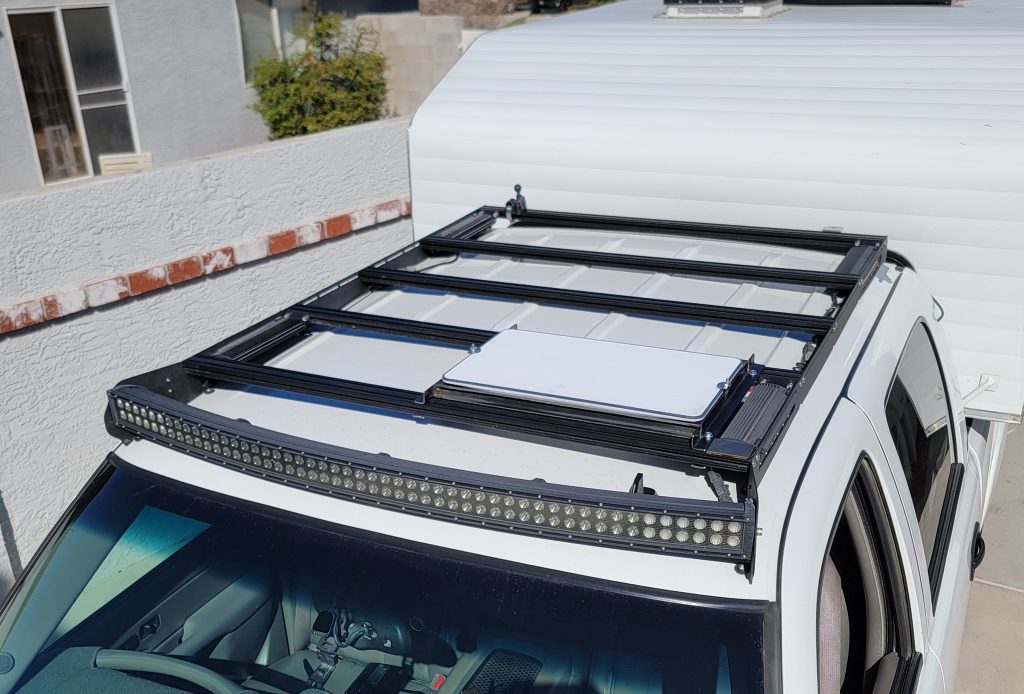
His testing has produced the same results as mine and it appears to work just as well as the round dish in motion.
Note: We now have a rectangular dish, see our installation here.
Update 4 No.4: Tie down modification for dish (1 May 22)
Finally got around to putting a switch in our motor-feed and adding some tie down loops. Now it’s very quick to remove from the tyre and use away from the truck on the tripod if needed. I’ve deliberately left a weak link between the tie-down loops and the studs from the back of the dish (I could have added a metal bar). This is so that, if something went wrong, the plastic case will break rather than the threaded rods being pulled out of the dish. The threaded rods are M5 and replace the original bolts. The extra two loops are to prevent the switch accidentally being switched.
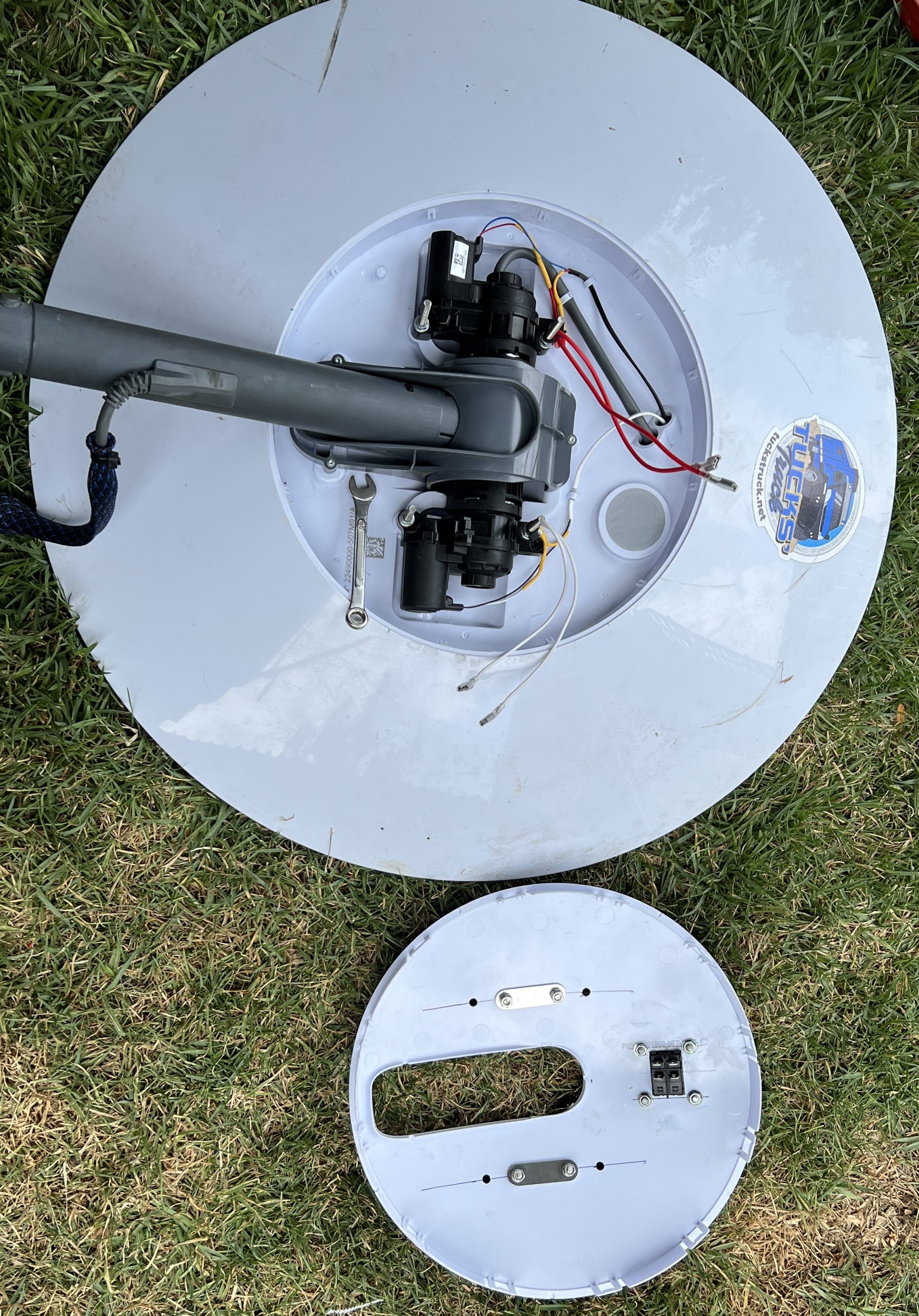
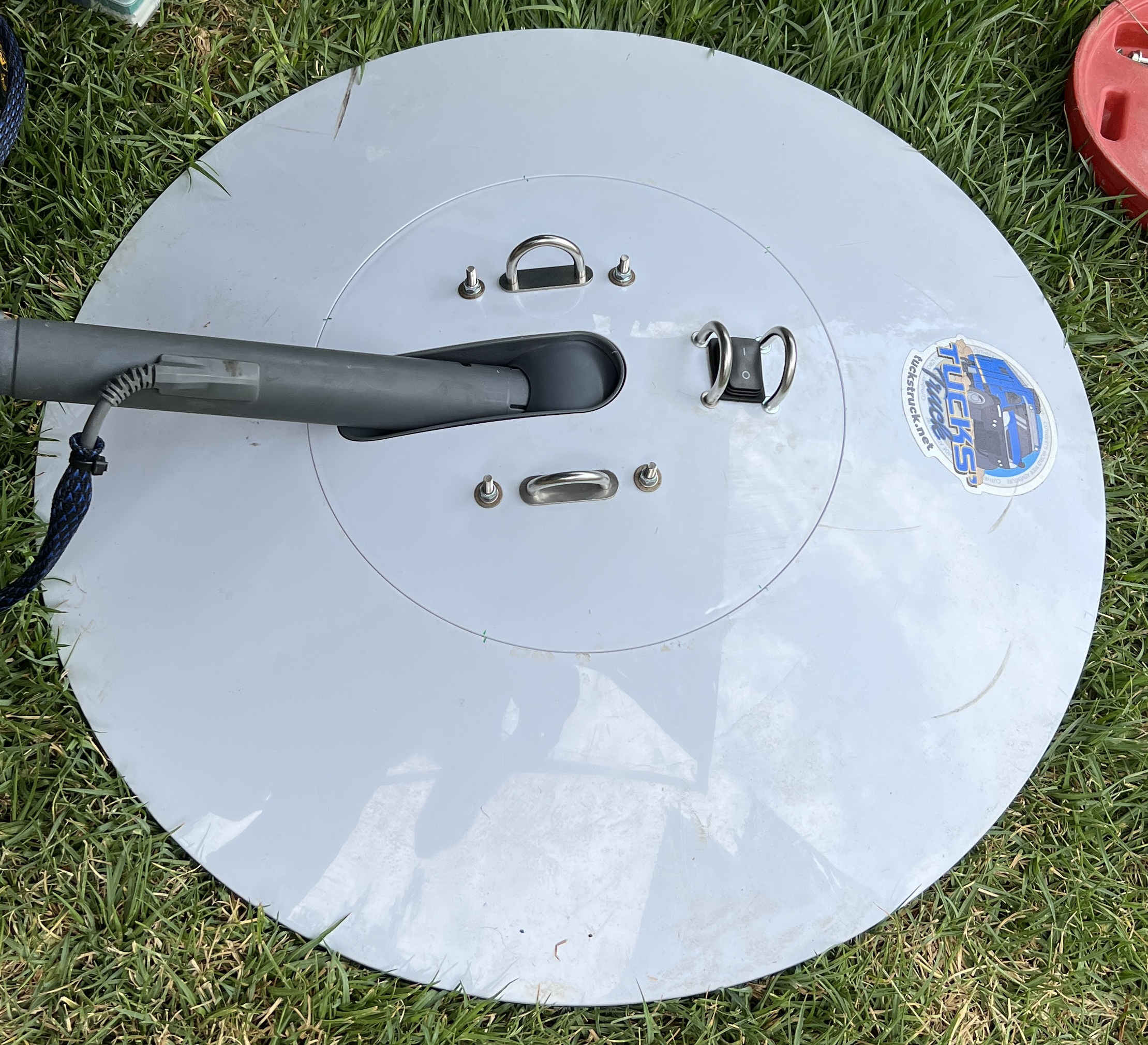
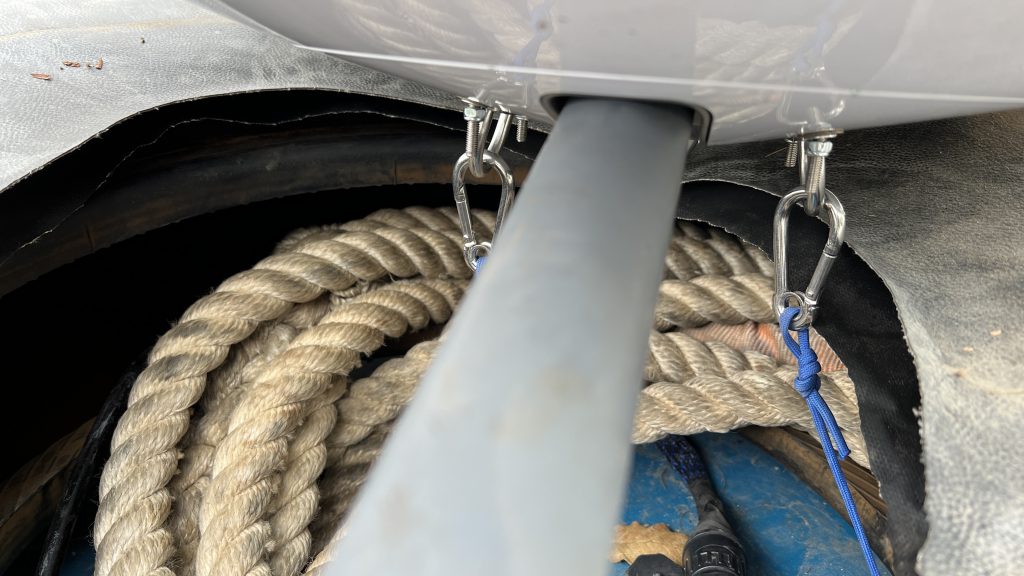
Update No. 5 Offical Portability announced (4 May 22)
Today we received an email announcing the subscription service “Portability”:
“Starlink is excited to announce Portability as an add-on feature for all Starlink customers. Portability enables customers to temporarily move their Starlink to new locations and receive high-speed internet anywhere where Starlink provides active coverage within the same continent. To see active coverage areas, please view the Starlink Availability Map
You can enable Portability for USD 25/month on your account page. Once enabled, Portability will take effect immediately, and you can disable Portability from your account page at any time.
To learn more about Starlink Portability, please read our FAQ page.”
The obvious limitations for us (as listed in the FAQ page) are:
“International Travel: Starlink can only be used within the same continent as the registered Service Address. If you use Starlink in a foreign country for more than two months, you will be required to move your registered service address to your new location or purchase an additional Starlink to maintain service.“
“Country Moves – We do not support Starlink use in a different country at this time. To use Starlink in a different country, you must create an account in the desired country.”
The ‘International Travel’ section says to change address to your foregin country location after two months, but the ‘Country Moves’ section says this cannot be done!
Also being limited to a single continent is also a problem. At present the only solution is to buy another system in the new country/continent!
Update No. 6: Report on testing above 57N in North America (23 Jul 22)
The SpaceX Starlink map is showing no service above 57N in North America, but I thought I’d give it a go to see what happens, but as expected… it didn’t work!
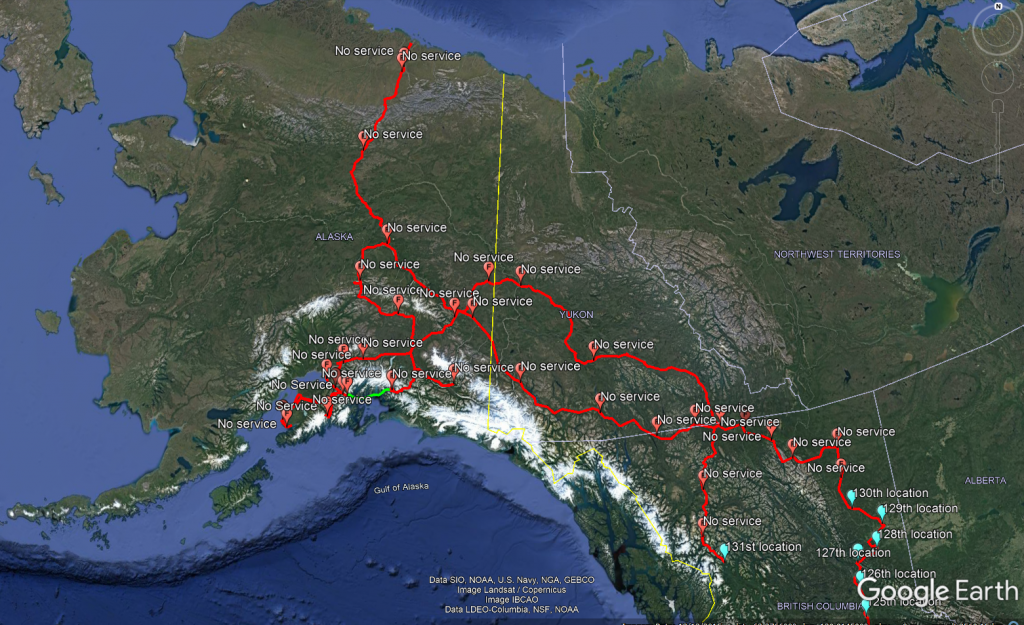
I used Orbitron with the TLE (Two Line Elements – the satellite orbital data) for the Starlink satellites to calculate when the 70 and 97.6 degrees Starlink satellites were overhead (there’s a window of several hours each day). This gave me a clue when to turn on my Starlink.
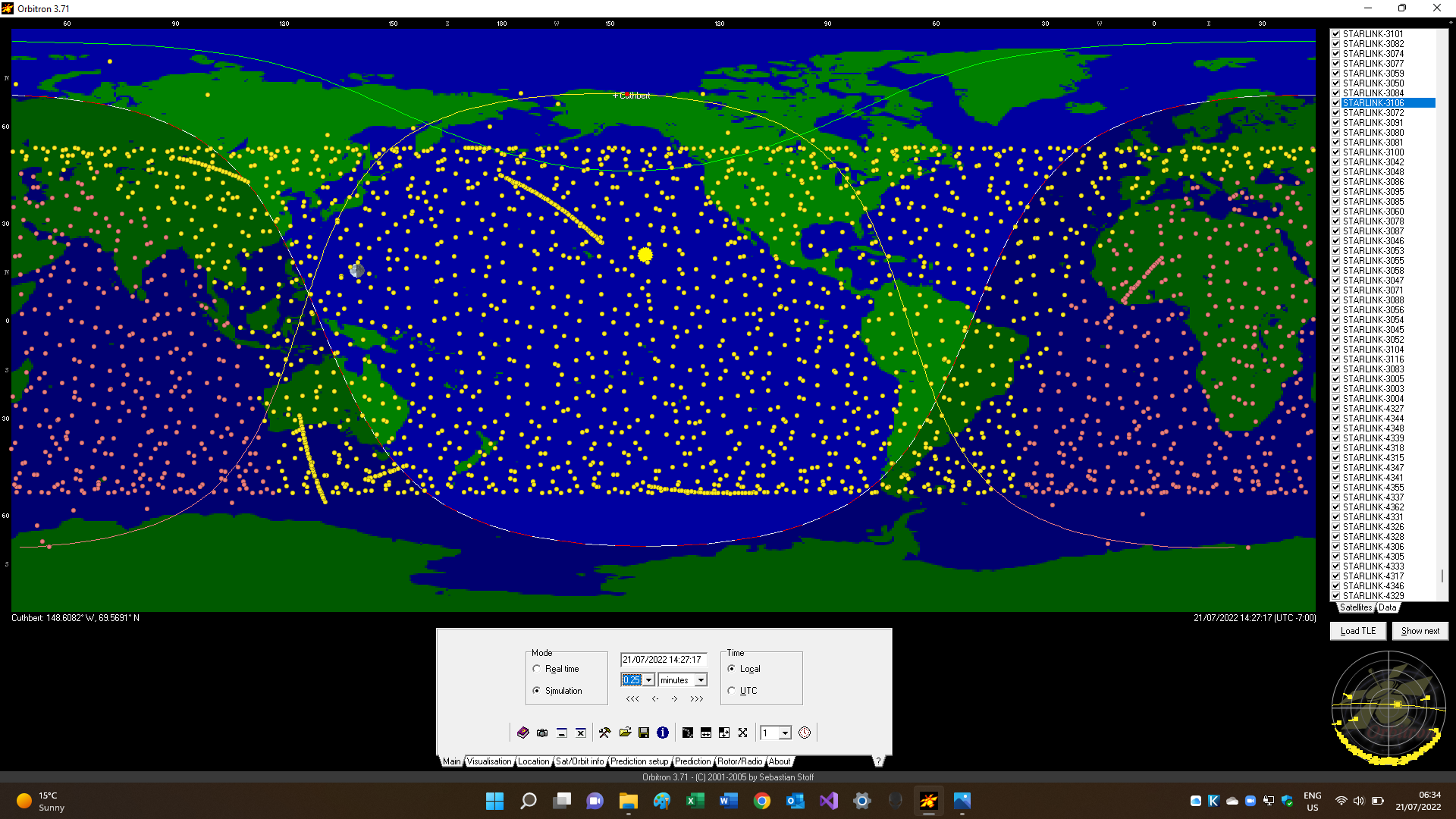
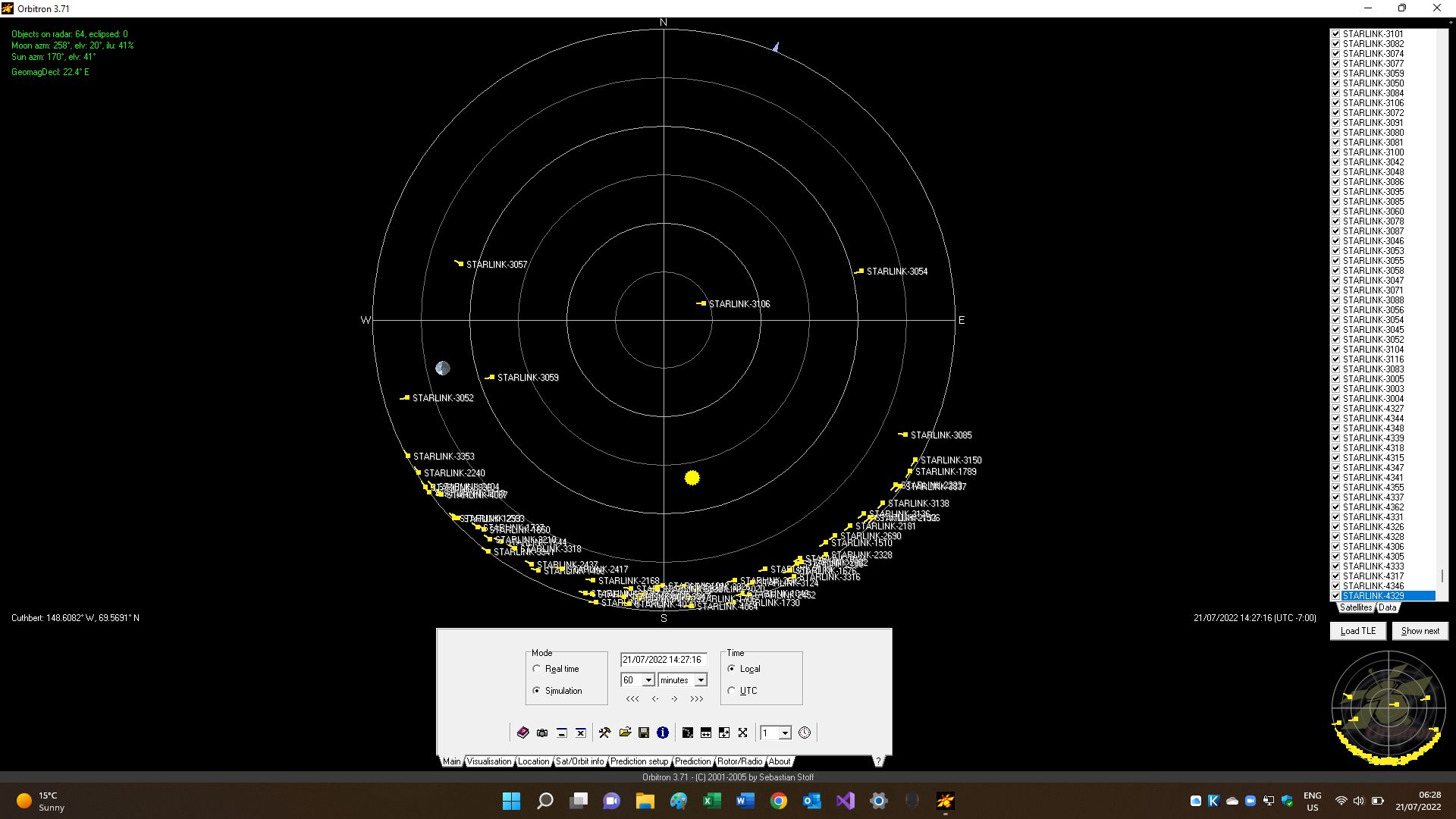
Looking at the debug data ‘DownlinkThroughputBps’, there was nothing from the high latitude satellites. I did get a few pings at 57.15N but no service, presumably these were from the 53 degrees satellites. Elon did Tweet on 10th Jun 2022 that the laser links between the satellites should be operational by the end of this year. I guess the lasers aren’t switched on yet, so the satellites out of range of a ground station can’t get data and hence provide a service yet.
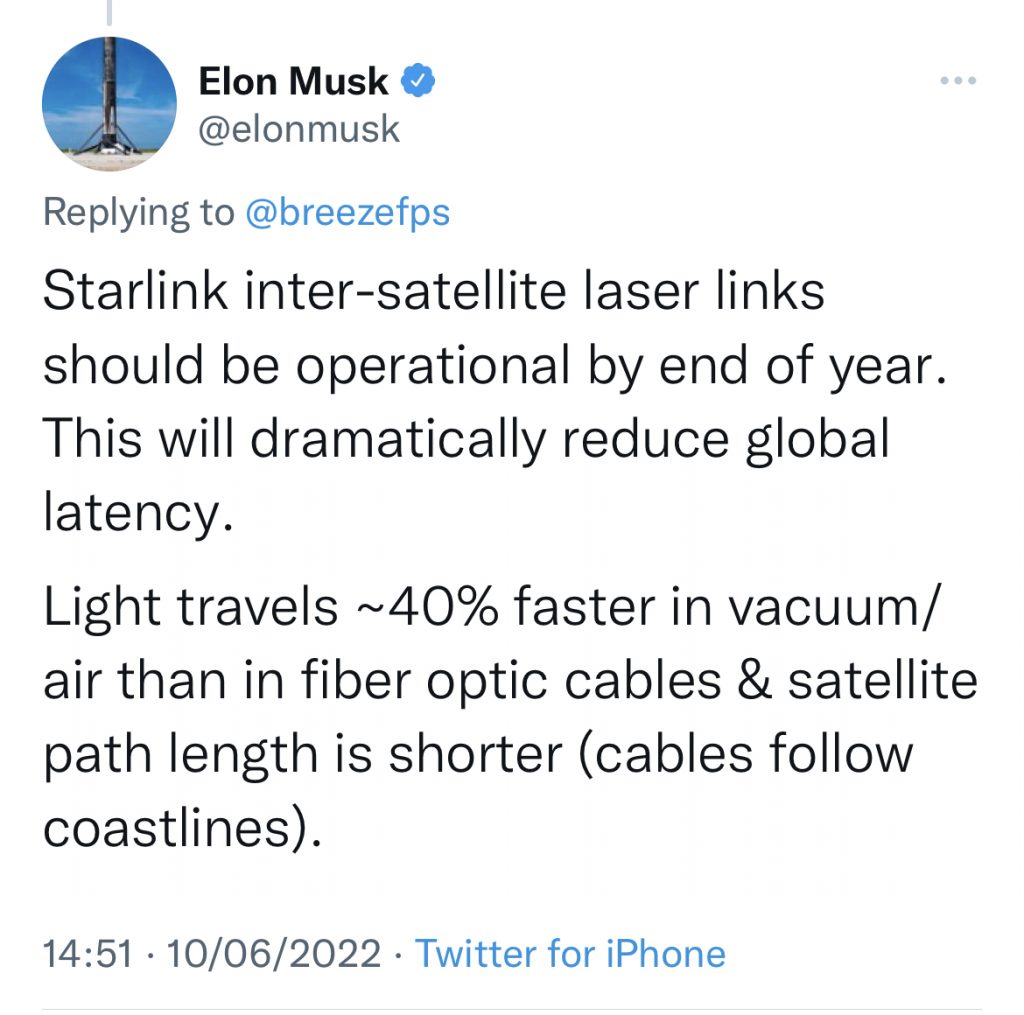
The SpaceX Starlink map is showing service starting above 57N in North America in the first quarter of 2023. But I also noticed that recently the SpaceX Starlink map has been updated to show coverage for Scotland, up to about 60N. I’m not sure why the coverage in North America hasn’t been raised to this higher latitude.

If you try to use the app ‘Visibility, Check for Obstruction’ function much above 57N it crashes the app! I guess it might have a ‘divide by zero’ calculation (or something like that) because the 53 degrees satellites are close to, or below, the horizon. I reported the issue to SpaceX.
Here is a screenshot of the obstruction view at 57N showing how small a letterbox the 53 degrees satellites are in at that latitude.
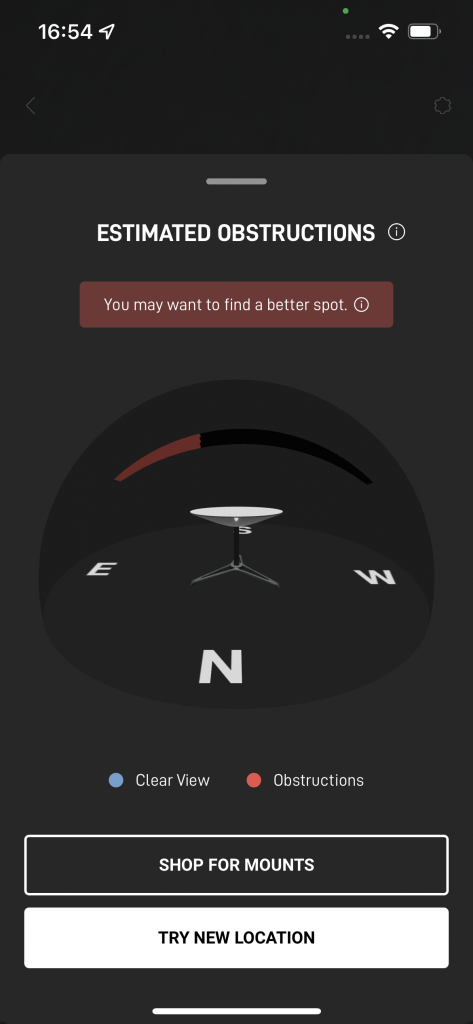
Click here for our other Starlink pages.
Update No. 7: FCC approval for SpaceX Starlink ‘Earth Station In Motion’ (26 Jul 22)
‘Earth Station in Motion’ (ESIM) is the industry standard term for the use of a satellite transceiver on a vehicle/vessel/aircraft whilst in motion.
It has recently been announced that the FCC has granted approval for SpaceX Starlink Earth Station In Motion (ESIM) use. Some have assumed that this approval applies to existing user terminals. However, if you read the FCC authorisation (click here) and the associated SpaceX application for ESIM (click here), it seems the approval probably isn’t for existing residential and business hardware.
The FCC authorisation refers to the “Consumer ESIM application” and “Enterprise ESIM application”. These would seem to refer to the Residential/RV and Business dishes respectively. However, the SpaceX application says:
“These ESIMs will be electrically identical with SpaceX Services’ next-generation fixed user terminals from a radiofrequency perspective, though they will have some additional features appropriate for a mobile operating environment (e.g., sensors to improve performance in motion and mountings that provide secure installation on trucks/RVs, boats, and aircraft).”
Further on the authorisation says:
“SpaceX notes that its ESIM terminals incorporate industry-standard technologies such as micro-electro-mechanical system (MEMS) inertial measurement unit (IMU) sensors and GPS receivers as well as advanced phased array antennas with efficient sidelobes to maintain correct point, detect mispointing, and cease transmission well within the 100-microsecond threshold to comply with requirements set forth in the Commission’s rules.”
From all of the above it seems that: the ESIM approved units have additional features for mobile use, possibly higher performance IMU sensors than the existing dishes; and the FCC authorisation for ESIM is conditional on this new higher spec. If this is the case, then it would follow that existing Residential/RV and Business dishes are not covered by the FCC ESIM authorisation. This would explain why SpaceX’s legal terms still prohibit in motion use for the current Residential/RV and Business dishes.
Note that the Maritime system does have ESIM approval so must be using the upgraded versions of the Business dish.
What might be positive news is that the FCC approval for ESIM refers to both an “Consumer ESIM application” and “Enterprise ESIM application”. This could mean that SpaceX plans to offer a cheap(er) in motion system based on the Residential/RV dish to the market for non-commercial users (RV etc), and a more expensive option based on the business dish for commercial use.
Update No. 8: Starlink and Geostationary Satellites (9 Aug 22)
I was asked on social media about the issue of using the dish mounted flat and the potential that it could be interfering with the geostationary satellites on similar frequencies. The first thing to remember with a phase array antenna is that the direction the antenna faces is not necessarily the direction it is transmitting. This is because the Starlink phase array steers the beam electronically, up to about 55 degrees in any direction from straight ahead.
When the dish is first turned on it normally moves to a horizontal position, which allows the best view of the sky in all directions. It then looks for the satellites and starts to communicate with them, but it only transmits in directions away from the geostationary satellites. After a short period (about 2 mins) the dish tries to move to point in an optimum direction. However, it can’t do this if it is mounted horizontally with the motors disabled. The dish detects that it hasn’t moved, generates a ‘Stuck Motor’ warning, then proceeds to work in this flat position.
The visibility diagrams below show the dish mounted horizontally and even with the dish in this position, it doesn’t use the sky in the direction of the geo stationary satellites (i.e. to the south for us in the Northern hemisphere). I am therefore confident that the horizontal mounting of the dish does not interfere with any geostationary satellites.
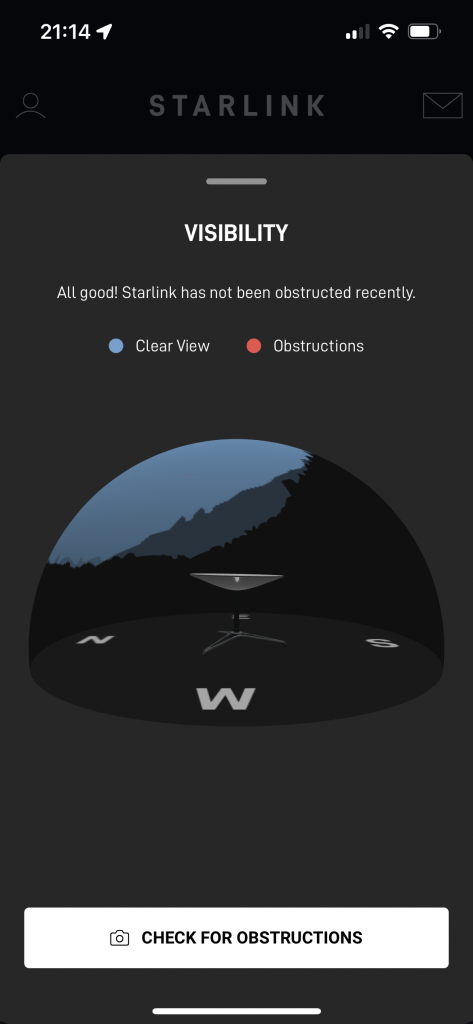
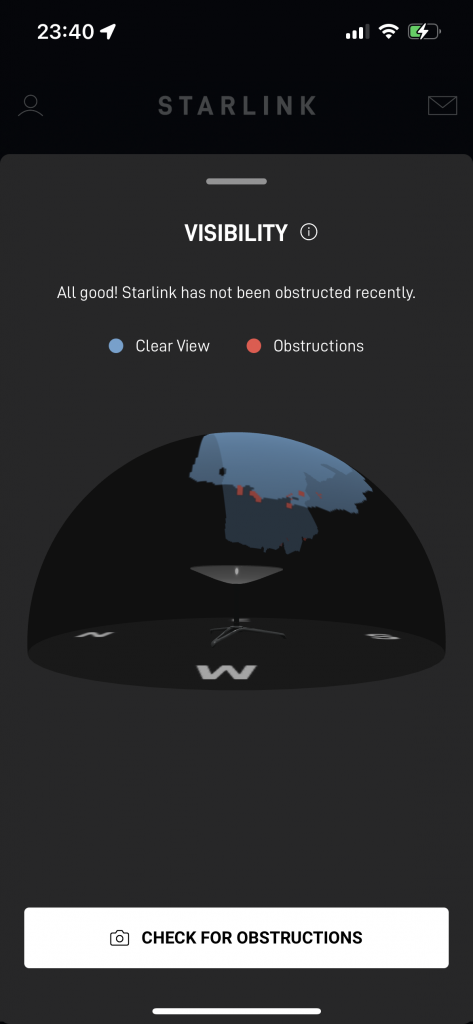
In the update #6 I mentioned that Starlink is now starting to serve locations between 57N and 60N which were not covered a few months ago. It seems that to achieve this, SpaceX now have enough data to reduce the ‘safety margin’ with regard to the amount of clearance required from the geostationary satellites. On the StarlinkEngineering sub-reddit, user u/_mother has done a very good analysis of this. With his permission I copy his analysis below:
Decreased GSO protection from 18º to 10º – big impact on coverage
Since a few reports came up on news sites and Twitter about increased coverage due North in places such as the UK and Sweden, I became intrigued as to how could Starlink do that, given the current state of the constellation (almost no satellites in the 70º and polar shells). The main issue for coverage due North, in the northern hemisphere, is GSO protection (discussed here and r/Starlink heavily in the past).
Here is what a satellite footprint looks like with an 18º GSO protection band – the top of the FOR is not available for service (blank cells):
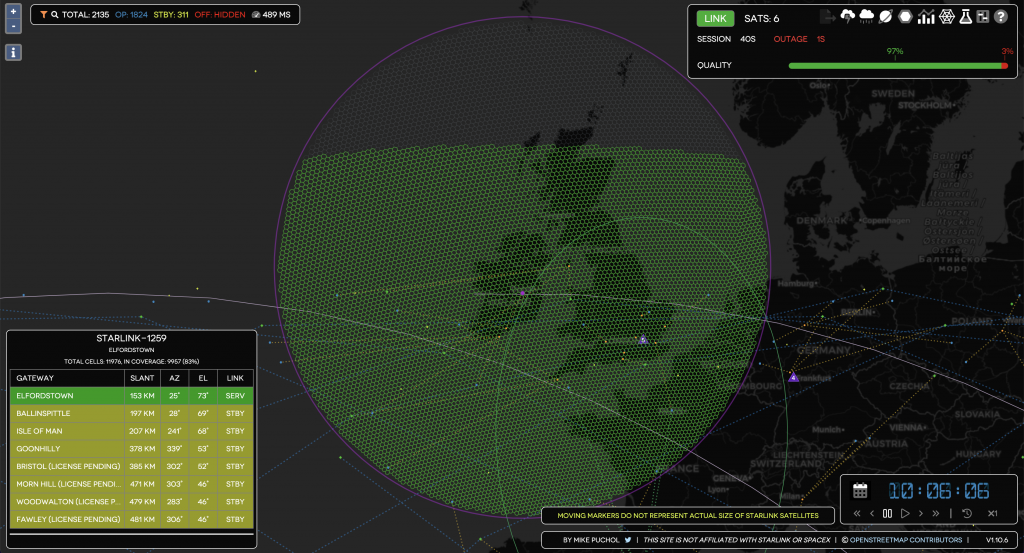
The unavailable portion means that North Scotland cannot get any service, no matter how many additional satellites are launched, or how much we decrease minimum elevation below 25º – GSO will nullify the effects. Thus, the only way that SpaceX could increase coverage due North is by reducing GSO protection. Let’s see what the FOR looks like if we adjust to 10º:
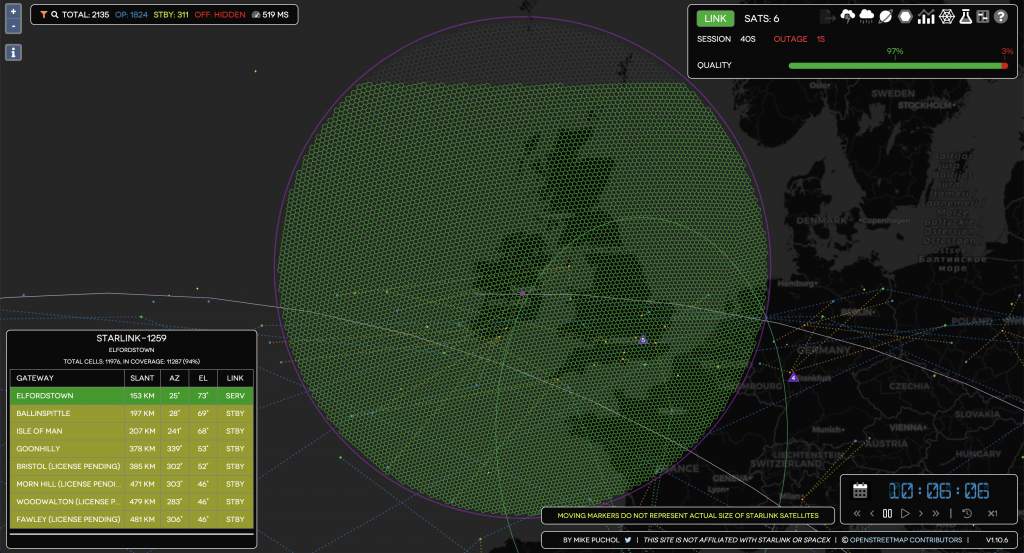
The same satellite is now able to cover cells all the way to the northern part of Scotland. If we compare the UK and Sweden cell heatmaps between 18º and 10º, they match exactly the increased coverage found on starlink.com/map
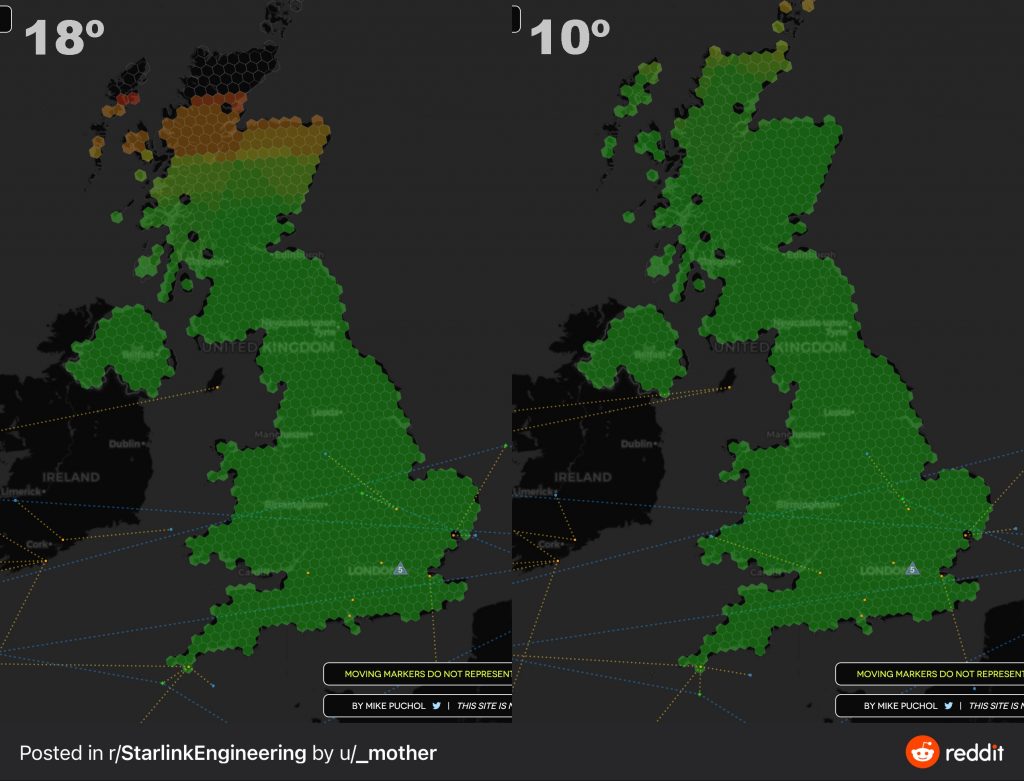
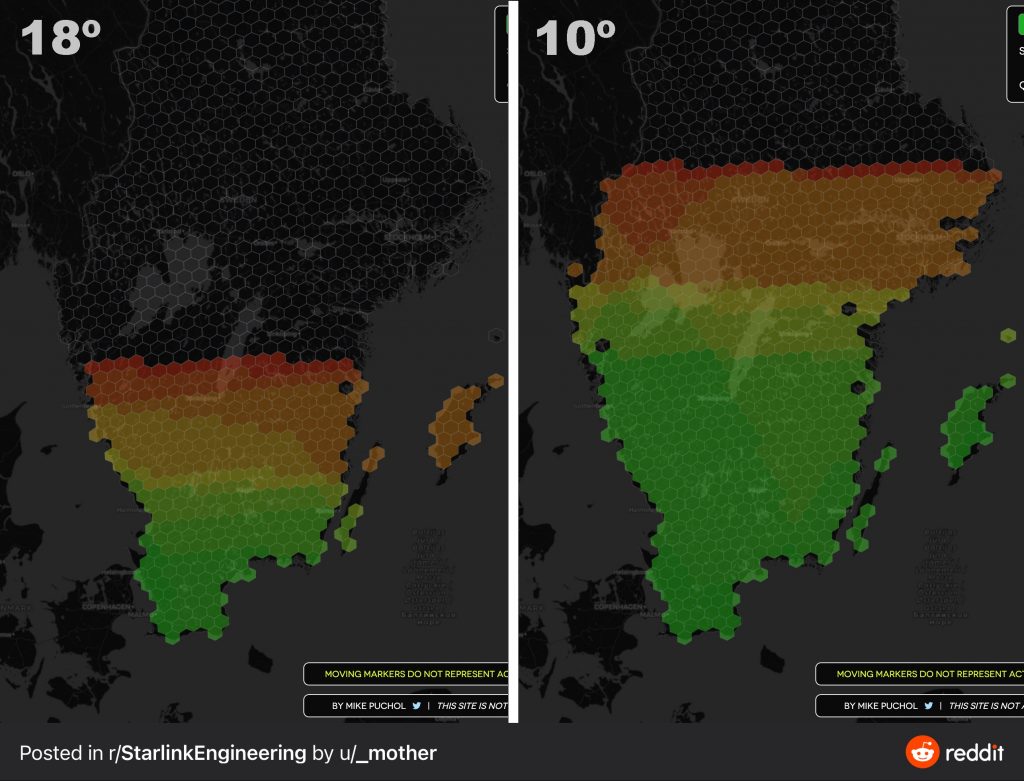
This is also why SpaceX has been able to activate some cells north of the current limit in Canada. The GSO protection slider is available on starlink.sx right now, I pushed v1.10.6 last night. Other changes detailed in a separate post.
Update No. 9: A few recent things we’ve noticed (22 Sep 22)
New Hardware Development – At the end of August 2022 SpaceX released 3D models of the user equipment on their Starlink website https://api.starlink.com/public-files/ReferenceModels.zip It appears they accidently included the 3D drawings for the yet to be released “Starlink_G1 Premium_Mobile_UT” but quicky removed it. This Mobile UT (User Terminal) appears to be a business dish with a flat rear mounting and a 7 degree slope on the face, presumably for drainage of rain and snow.
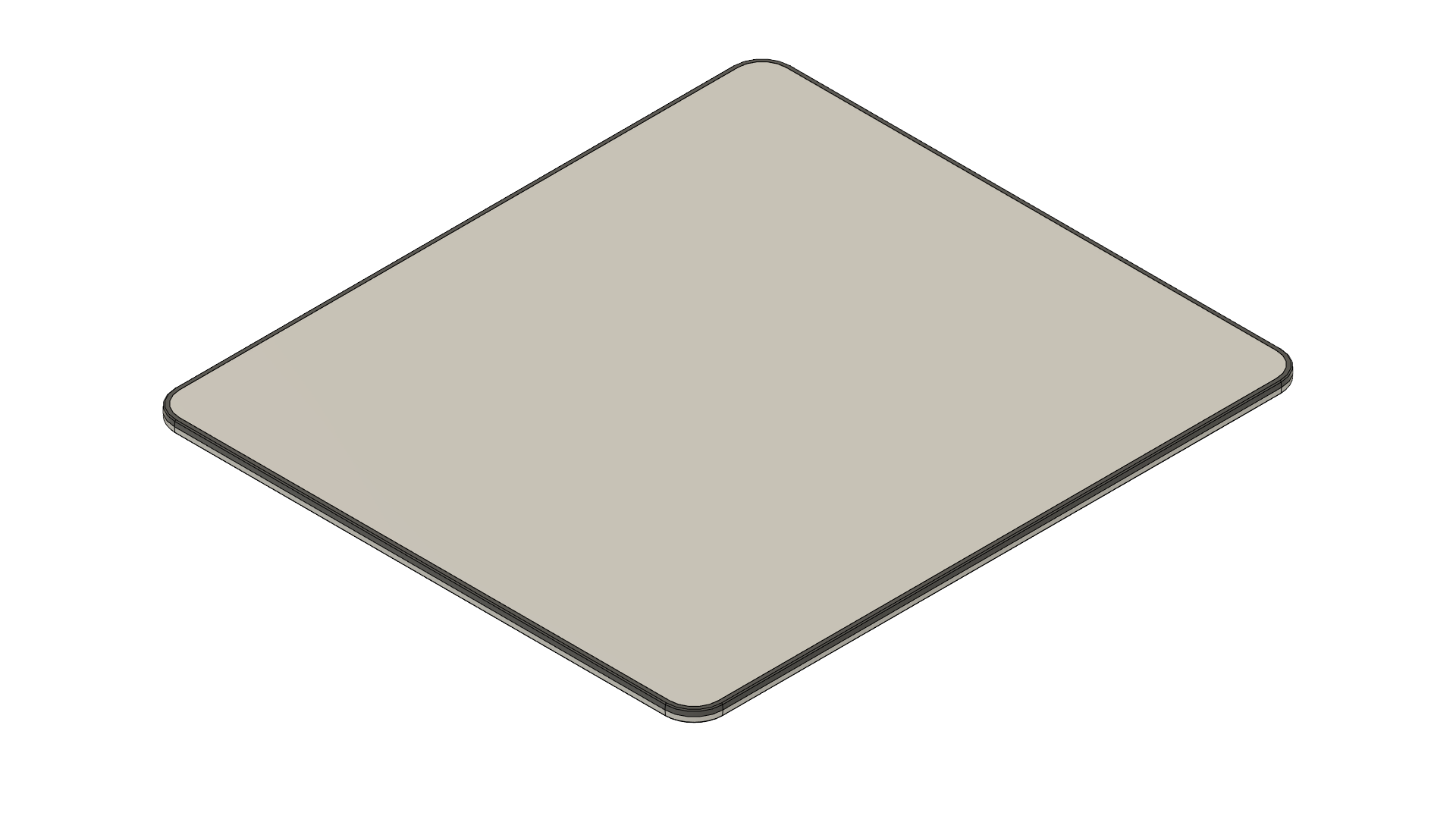
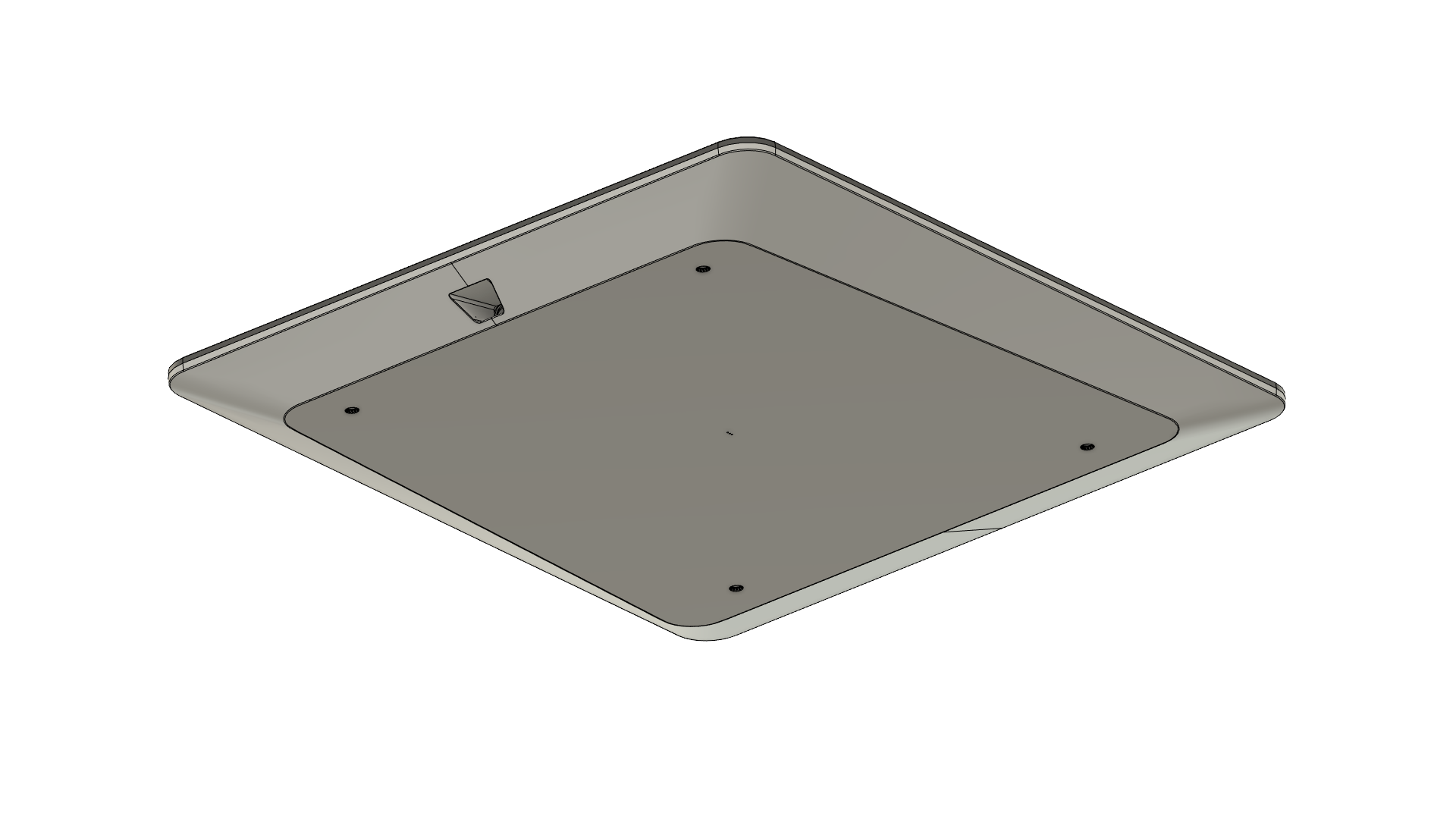
Improvement to flat-mounted operation – (change since software update 79170122-8b62-4124-865e-05dbeaf764e9.uterm.release which we received 18 Sep 22) when turned on with the motors disconnected, the system no longer drops out for a couple of minutes when it tries to move the dish with the motors. It now detects the dish has not moved (because our motors are disconnected) and just continues working.
No more ‘in motion’ service – (change on our account since software update 79170122-8b62-4124-865e-05dbeaf764e9.uterm.release which we received 18 Sep 22) if the dish detects vehicle speed in excess of 10 mph (16 kph) it goes off-line until the speed drops below 10 mph (16 kph). I see from social media that not all users with this software have lost in-motion yet, so it seems this feature may be controlled at the account level (a bit like Portability) rather than by the software update alone. I’m guessing that in-motion usage could become a subscription service in the future, but will probably require users to buy the new in-motion hardware before subscription will be allowed.
Residential-Portability -v- RV Service – While camping in a couple of spots with our Residential Portability service, we have had very slow (less than 1 Mbs) Starlink speeds and a warning about congestion at peak times. On both occasions we updated our registered address to our current location and within 10 minutes our speeds returned to normal (>50 Mbs). This is one great advantage of the Residential Portability service over the RV version. However, if (with a Residential Portability service) you use your dish at home as well as on your RV, you must remember that updating your address to a new location means that you could lose your address at home by the time you return. This isn’t an issue for us as we don’t have a permanent home, living full time in our RV.
Update No.10: Flat High Performance dish and laser links (2/10/22)
Flat High Performance Dish
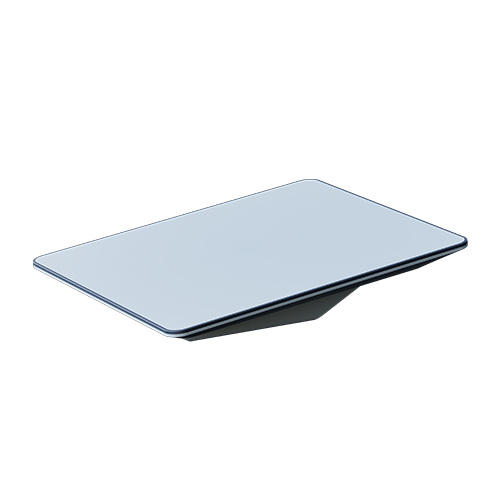
A week after our last update, SpaceX released information on the ‘Flat High Performance’ dish. It is only available to Maritime customers at present but may be released to others in the future. More information about this new dish is available here:
Full description: https://www.starlink.com/specifications?spec=3
Installation guide: https://api.starlink.com/public-files/WedgeMountGuide_MobileHP_English.pdf
Detailed specifications including wiring pin-out: https://api.starlink.com/public-files/Starlink%20Product%20Specifications_FlatHighPerformance.pdf
Technical drawings: https://api.starlink.com/public-files/ReferenceModels.zip
Hopefully there will be a ‘Flat Standard’ dish in the future for vehicles and RVs.
Laser Links
SpaceX have sent letters to users in several areas to explain that they are using the laser links between the satellites to provide service:
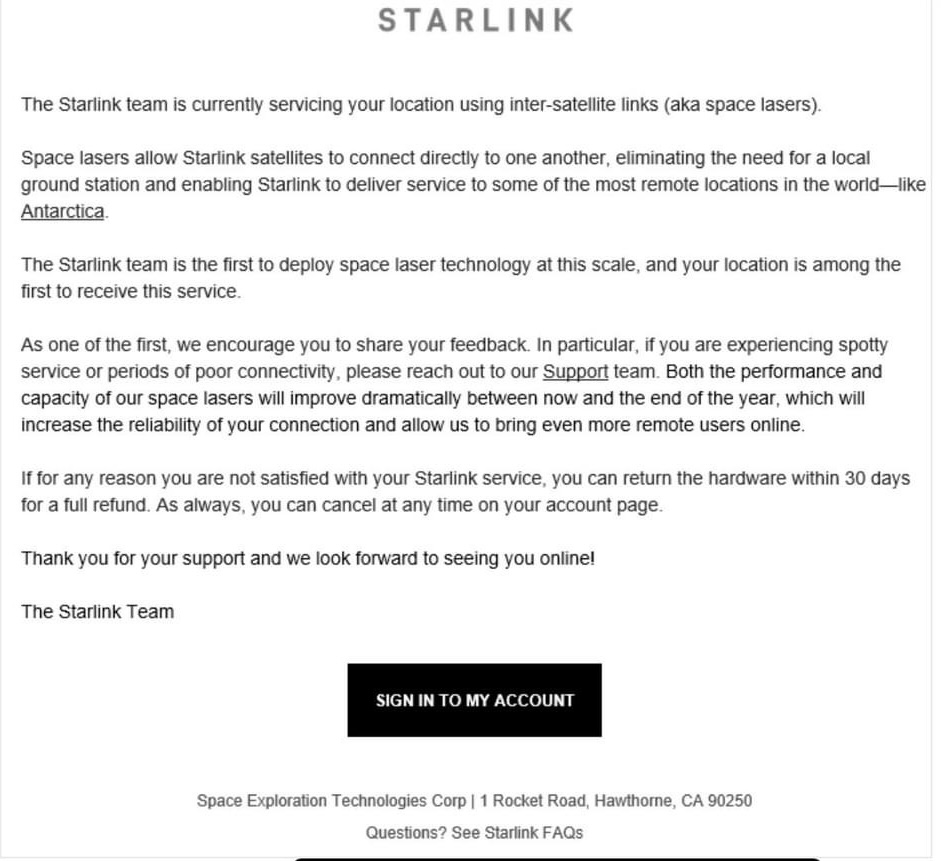
This has allowed more coverage in Northern Australia and the Azores. Hopefully more remote locations will open soon with this technology.
Update No. 11: In-motion working again (3/10/22)
As discussed in Update 9 above, when the Dish started to detect vehicle speeds in excess of 10 mph (16 kph), it would go off-line until the speed dropped below 10 mph (16 kph). However, following software update ab8d4db3-bd07-45c3-a456-9f340a2d6360.uterm.release on 3 Oct 22, in-motion above 10 mph (16 kph) is working again.
I understand from social media that not all users with these software updates lost the in-motion facility, so my thought is that this feature may be controlled at the account level (a bit like Portability) rather than by the software update alone. I still believe that the current in-motion usage will, at some point in the future, be switched-off and become an additional subscription service (probably requiring users to buy new in-motion hardware before subscription will be allowed).
Update No. 12: Global Roaming, end of Portability and price changes in the USA (24/2/23)
In the last week there have been a few updates from SpaceX about Starlink services:
Starlink Global Roaming Service
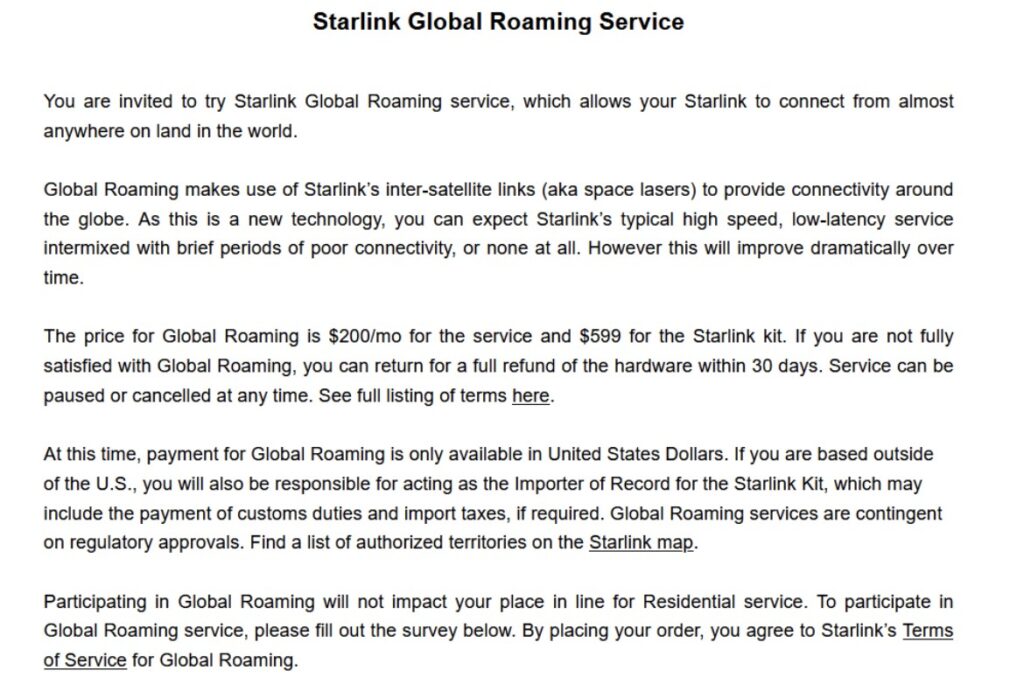
Some users got an invitation to the Starlink Global Roaming service, the message said: “Starlink Global Roaming service, which allows your Starlink to connect from almost anywhere on land in the world.
Global Roaming makes use of Starlink’s inter-satellite links (aka space lasers) to provide connectivity around the globe. As this is a new technology, you can expect Starlink’s typical high speed, low latency service intermixed with brief periods of poor connectivity, or none at all. However this will improve dramatically over time.
The price for Global Roaming is $200/mo for the service and $599 for the Starlink kit.”
Unfortunately, this is quite expensive and may not be too popular with long term travellers like us. In some cases, particularly for slower travellers, it works out cheaper to buy and sell Starlink systems as you move around the world than it is to buy this Global Roaming system.
Let’s take the current pricing in Mexico as an example. A tourist visa is usually allowed in Mexico for 6 months, but let’s say you buy a Starlink system in Mexico and stay 3 months. Then you move on to Guatemala and continue using your Starlink for 2 more months (this 2 month limit in another country is not enforced by Starlink at present but probably will be at some point). The purchase price is Mx$8300 (US$447), plus Mx$1350 (US$73) per month for 5 months, that is a total of US$812 for 5 months Starlink use. Global Roaming excluding the hardware price, would cost US$1000 for the same period. Due to a lack of clarity in Starlink’s rules, it may or may not be possible to continue using the system into a third country and get even better value out of the basic system, but even if that’s not possible and you end up having to sell the system and buy new in the next country, it is still cheaper to buy a new dish every 5 months. And the longer you stay in a country (say, if you stay in Mexico 6 months rather than 3 months) it is even cheaper! Obviously, rates vary from country to country around the world, so this needs to be reviewed for your specific journey, but it’s definitely worth checking before investing in the pricey Global Roaming system.
The end of Portability for Residential and price changes for RV in the USA
In the USA, Portability is no longer available if you do not already have it active on your residential account. This means residential users can no longer add portability so they can take their Starlink with them when they travel or on holidays. If you already have portability active on your account, they will not take it off you, but if you cancel it you cannot get it back again!
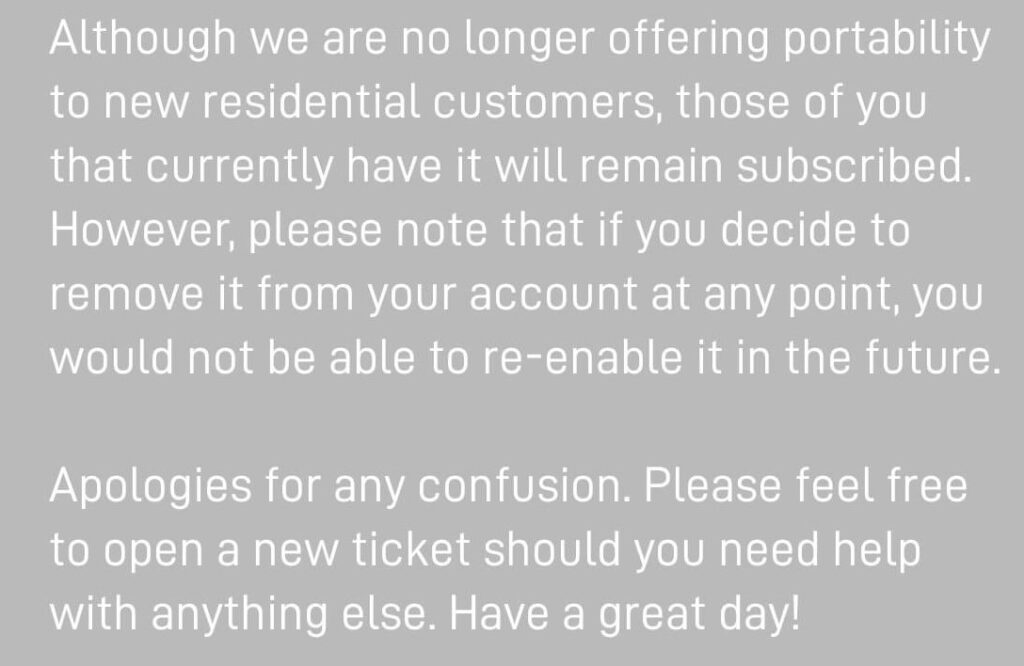
For residential users they are also changing the pricing in the USA:
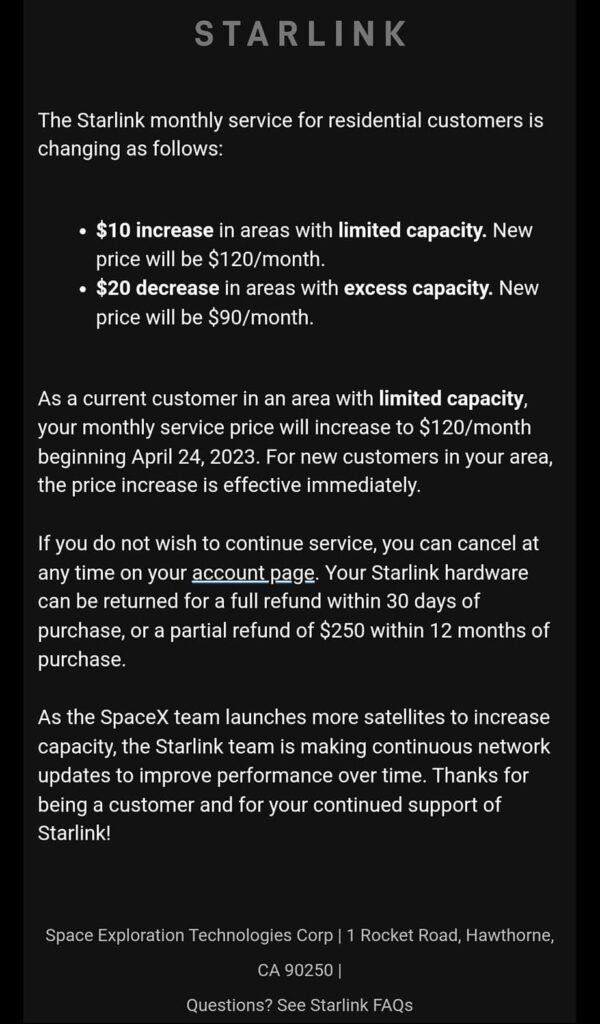
“The Starlink monthly service for residential customers is changing as follows:
o $10 increase in areas with limited capacity. New price will be $120/month.
o $20 decrease in areas with excess capacity. New price will be $90/month.
As a current customer in an area with limited capacity, your monthly service price will increase to $120/month beginning April 24, 2023. For new customers in your area, the price increase is effective immediately.”
This means for overlanders like us, the only option now for travel in the USA is RV (if you haven’t already got Residential with Portability). The RV pricing in the USA is also changing:
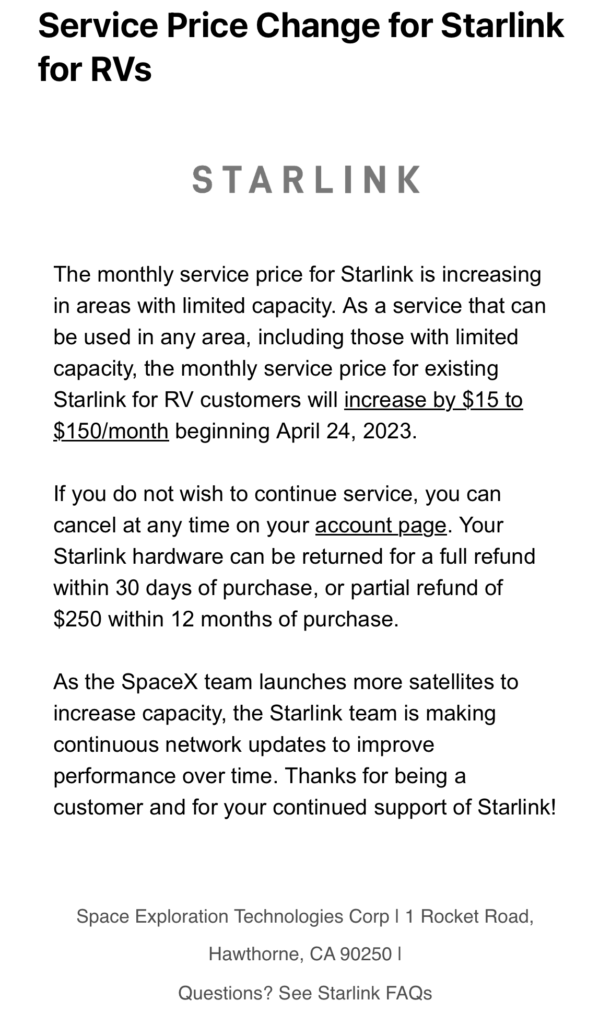
“The monthly service price for Starlink is increasing in areas with limited capacity. As a service that can be used in any area, including those with limited capacity, the monthly service price for existing Starlink for RV customers will increase by $15 to $150/month beginning April 24, 2023.”
These changes do not affect countries other than the USA at present but, could be a sign of things to come for the rest of the world as Starlink evolves.
_____________________________________________________________________________________________
**NOTE ON STARLINK ‘IN MOTION’: Today (5 May 22) we noticed that SpaceX have updated their legal documents as follows:
“IN-MOTION USE PROHIBITED. USING STARLINK SERVICES IN-MOTION ON A VEHICLE OR VESSEL (e.g., CARS, VANS, RVs, BOATS) IS PROHIBITED, WILL VOID THE LIMITED WARRANTY OF YOUR KIT, AND MAY BE GROUNDS FOR THE TERMINATION OF YOUR AGREEMENT WITH STARLINK PER SECTION 10 OF THESE TERMS. AT THIS TIME, STARLINK EQUIPMENT IS NOT CONFIGURED TO BE SAFELY USED IN-MOTION OR INSTALLED ON A VEHICLE OR VESSEL.”
https://www.starlink.com/legal/documents/DOC-1020-91087-64?regionCode=US
However, their FAQs still have a slightly different warning on the subject:
“No In-Motion Use: We do not support Starlink use in motion at this time. Using the Starlink Kit in motion will void the limited warranty of your Kit. While our teams are actively working to make it possible to use Starlink on moving vehicles (e.g., automobiles, RVs, boats), Starlink is not yet configured to be safely used in this way.”
As a result of the legal document update, we no longer use Starlink in motion.
